E.G. Wolverson's Blog, page 3
February 9, 2020
App / Streaming Service Review | Amazon Prime Video
“No, not really,” was the response that immediately leapt to mind when my mobile provider asked me if I’d like a six-month free trial of Amazon Prime Video. Having tried the service periodically before – whenever Amazon have pushed a free trial on me or the missus – I had always found it difficult to navigate; riddled with bugs; and, crucially, chock full of movies and shows that I either already owned or had no interesting in watching. This all changed when I heard that Prime had secured the rights to stream the then-upcoming
Star Trek: Picard
in the UK. “No, not really,” quickly became, “Yes please!”
It’s telling, though, that in my five-month wait for Star Trek: Picard to drop, the only show that I watched on the platform was DC’s Swamp Thing (a bold and singularly scary series inexplicably cancelled by DC Universe as soon as its first episode aired), but even that could have been enjoyed elsewhere as it is now widely available for purchase digitally and on Blu-ray. One of my daughters has also watched a few Little Princesses, and together this accounts for the total sum of our household’s pre-Picard viewing. Admittedly, there is a plethora of content available on the platform that we love (the American version of The Office, Smallville , Arrow …) but why would we waste gigabytes of our monthly usage allowance streaming it over the Internet when we could just watch it on Apple TV using home sharing? Why to pay to rent what we’ve already purchased outright?
One such reason might be a better interface, which Prime Video does not have. In fact, Prime’s apps are even worse than NOW TV’s; ugly and laden with traps. Whilst the landing screen at least has the reserve to limit its offerings to those tagged with “Prime” in the top-left corner, if you search for a movie or programme you will often get a positive result even if the video in question isn’t available to stream as part of the subscription package. For adult subscribers watching alone, this is probably a bit annoying; for those of us with kids, it makes life impossible. “But it’s found it, Dad, look!” This mandatory store integration might be welcome for those heavily invested in the Amazon ecosystem, who also want to use the Prime Video app to stream the videos that they’ve bought from Amazon, but I’m sure that most subscribers to the streaming service would prefer a cleaner interface such as those offered by their main competitors. There’s nothing to prevent Amazon creating a separate app for consumers to make and stream their purchases or, better still, download them to PCs or home media servers to share within their homes along the lines of iTunes’ home sharing via the Apple TV’s Computers app.
Another reason would be simple convenience, but again Prime Video crashes and burns. The unpleasantness of the cheap-looking layout is indicative of the service’s rigid and clunky functionality – trying to skip backwards and forwards is a painful experience irrespective of which app or remote I’m using, while crucial functions like zoom are missing entirely. This was a particular problem for me as both shows that I watched during my free trial were letterboxed. For some elusive reason, the ability to blow up a picture is disabled entirely on my Samsung TV’s Prime app (the app actually goes to the trouble of overriding the TV’s built-in zoom feature, leaving it greyed out), while the tvOS app for Apple TV does not respond to the remote’s convenient double-tap zoom. Similarly, the iOS apps prevent you from blowing up an image, which is particularly preposterous on an iPad, where a 2.35:1 video fills only about half the available screen. The only way I could get Picard into 16:9 was by watching it on the Apple TV’s Prime app while using my Samsung TV to blow up the entire Apple TV input (controls and all) from 2.35:1 to 16:9. Losing a bit off the sides of an image may be heresy to some purists, but for me the opposite is true. Whatever your view, though, if studios are going to deliberately make a TV programme the wrong shape, then viewers should at least retain the choice of how they want to view it. Amazon, in their dictatorial wisdom, take that decision away from you.
Another key failing of Prime is the iOS apps’ download supposed download function. Even with the download quality set at “Best”, a forty-four-minute episode of Picard weighs in at a paltry 215.7MB. To put that in context, a 64-second Doctor Who trailer for that I recently downloaded from iTunes takes up 43.8MB disc space. On an iPhone 6s Plus’s 5.5” 1080p screen, trying to watch downloaded Prime content is scarcely any better than watching an old .avi file on a mid-’90s CD-ROM or dial-up Internet connection. I’d take a screengrab to illustrate my point but, true to form, none of the Prime Video apps support them – you can screengrab the menus all you like, but if media is playing, then you’ll either just get a blank screen or a blank screen with the interface on top. Another red cross for Prime.
A further irritation for me is my watchlist’s tendency to populate itself. It’s as if it’s incredulous that I’ve only got Picard on there; it can’t accept it, so it takes matters into its own hands and starts loading it up with whatever mass-market tripe Amazon Studios have recently farmed out. Having to suffer through unsolicited and irrelevant trailers half the time I try to watch anything is bad enough, but don’t go sticking them on my watchlist.
Watching Picard, though, one unexpected feature has really impressed me – X-ray. Exhaustive cast metadata is commonplace now; any half-decent media server (Plex, Emby, MediaPortal…) can readily extract information from IMDB or the TVDB and turn it into a prettier-than-Prime interface, but Prime Video is the first that I’ve come across to offer scene-specific cast information. I discovered the feature by accident when pausing the show, but have found it particularly enlightening ever since. I was convinced Marvel’s Clark Gregg was playing a Romulan in “Maps and Legends”, but thanks to X-ray, I could prove myself wrong without even having to reach for my phone. At last, Prime earns its first green tick.
Another welcome feature is how Prime deals with movies and programmes that will be leaving the service soon. These are all clearly identified and even promoted on the apps’ landing pages, encouraging viewers to get them watched while they can. Of course, the very need for this feature highlights Prime’s greatest failing: its continuing dependence on third-party content, the extent of which is diminishing as more and more studios claw back their own content to host on rival services. While Amazon offers a wide array of “Originals”, as they stand they are hardly comparable to Disney’s peerless archives, let alone the combined output of BBC and ITV. There’s not a single, Amazon-produced programme (i.e. a genuine “Original”, as opposed to licenced ones like Picard and Swamp Thing) currently on the service that appeals to me. That will change if the long-rumoured Lord of the Rings prequel series ever drops, of course, but that particular project is still without an expected date, two and a half years on from being announced.
Another coup for the service is its recently-acquired Premiership football, which for too long has been the exclusive preserve of BT and Sky. With only “up to” twenty games all season, though, it’s little more than a taster for viewers, as opposed to a viable means of following the competition. Again, Prime isn’t setting itself up as a workable alternative to the market leaders here – for now, it’s just a purveyor of a limited number of matches that other broadcasters can’t get or don’t want.
For £7.99 per month or £79.00 per year, Prime Video offers its subscribers a random assortment of eclectic entertainment that’s quite capable of keeping any household entertained for a while, subject of course to personal tastes and the extent of people’s own media libraries. However, it lacks the enticing focus of cheaper offerings such as Britbox and the upcoming Disney+, both of which offer near-exhaustive libraries of particular types of content for £2.00 per month less (£29.01 per year less, if you take Disney+ up on their pre-order offer). Prime can’t market itself as the home of Star Trek , for instance, or even the exclusive home of Premiership football, because it’s not – it’s mostly just a rag-tag assemblage of smash and grabs, devoid of identity and permanence. Unless you simply can’t wait for Picard’s eventual home video release, Prime is a service best avoided – even when it’s offered for free.
You can start a 30-day free trial of Prime Video by signing up here. If you’re only planning to watch Picard, you might want to hold fire until at least 27th February 2020 to make sure you can watch the whole thing without having to become a paid subscriber.
It’s telling, though, that in my five-month wait for Star Trek: Picard to drop, the only show that I watched on the platform was DC’s Swamp Thing (a bold and singularly scary series inexplicably cancelled by DC Universe as soon as its first episode aired), but even that could have been enjoyed elsewhere as it is now widely available for purchase digitally and on Blu-ray. One of my daughters has also watched a few Little Princesses, and together this accounts for the total sum of our household’s pre-Picard viewing. Admittedly, there is a plethora of content available on the platform that we love (the American version of The Office, Smallville , Arrow …) but why would we waste gigabytes of our monthly usage allowance streaming it over the Internet when we could just watch it on Apple TV using home sharing? Why to pay to rent what we’ve already purchased outright?
One such reason might be a better interface, which Prime Video does not have. In fact, Prime’s apps are even worse than NOW TV’s; ugly and laden with traps. Whilst the landing screen at least has the reserve to limit its offerings to those tagged with “Prime” in the top-left corner, if you search for a movie or programme you will often get a positive result even if the video in question isn’t available to stream as part of the subscription package. For adult subscribers watching alone, this is probably a bit annoying; for those of us with kids, it makes life impossible. “But it’s found it, Dad, look!” This mandatory store integration might be welcome for those heavily invested in the Amazon ecosystem, who also want to use the Prime Video app to stream the videos that they’ve bought from Amazon, but I’m sure that most subscribers to the streaming service would prefer a cleaner interface such as those offered by their main competitors. There’s nothing to prevent Amazon creating a separate app for consumers to make and stream their purchases or, better still, download them to PCs or home media servers to share within their homes along the lines of iTunes’ home sharing via the Apple TV’s Computers app.
Another reason would be simple convenience, but again Prime Video crashes and burns. The unpleasantness of the cheap-looking layout is indicative of the service’s rigid and clunky functionality – trying to skip backwards and forwards is a painful experience irrespective of which app or remote I’m using, while crucial functions like zoom are missing entirely. This was a particular problem for me as both shows that I watched during my free trial were letterboxed. For some elusive reason, the ability to blow up a picture is disabled entirely on my Samsung TV’s Prime app (the app actually goes to the trouble of overriding the TV’s built-in zoom feature, leaving it greyed out), while the tvOS app for Apple TV does not respond to the remote’s convenient double-tap zoom. Similarly, the iOS apps prevent you from blowing up an image, which is particularly preposterous on an iPad, where a 2.35:1 video fills only about half the available screen. The only way I could get Picard into 16:9 was by watching it on the Apple TV’s Prime app while using my Samsung TV to blow up the entire Apple TV input (controls and all) from 2.35:1 to 16:9. Losing a bit off the sides of an image may be heresy to some purists, but for me the opposite is true. Whatever your view, though, if studios are going to deliberately make a TV programme the wrong shape, then viewers should at least retain the choice of how they want to view it. Amazon, in their dictatorial wisdom, take that decision away from you.
Another key failing of Prime is the iOS apps’ download supposed download function. Even with the download quality set at “Best”, a forty-four-minute episode of Picard weighs in at a paltry 215.7MB. To put that in context, a 64-second Doctor Who trailer for that I recently downloaded from iTunes takes up 43.8MB disc space. On an iPhone 6s Plus’s 5.5” 1080p screen, trying to watch downloaded Prime content is scarcely any better than watching an old .avi file on a mid-’90s CD-ROM or dial-up Internet connection. I’d take a screengrab to illustrate my point but, true to form, none of the Prime Video apps support them – you can screengrab the menus all you like, but if media is playing, then you’ll either just get a blank screen or a blank screen with the interface on top. Another red cross for Prime.
A further irritation for me is my watchlist’s tendency to populate itself. It’s as if it’s incredulous that I’ve only got Picard on there; it can’t accept it, so it takes matters into its own hands and starts loading it up with whatever mass-market tripe Amazon Studios have recently farmed out. Having to suffer through unsolicited and irrelevant trailers half the time I try to watch anything is bad enough, but don’t go sticking them on my watchlist.
Watching Picard, though, one unexpected feature has really impressed me – X-ray. Exhaustive cast metadata is commonplace now; any half-decent media server (Plex, Emby, MediaPortal…) can readily extract information from IMDB or the TVDB and turn it into a prettier-than-Prime interface, but Prime Video is the first that I’ve come across to offer scene-specific cast information. I discovered the feature by accident when pausing the show, but have found it particularly enlightening ever since. I was convinced Marvel’s Clark Gregg was playing a Romulan in “Maps and Legends”, but thanks to X-ray, I could prove myself wrong without even having to reach for my phone. At last, Prime earns its first green tick.
Another welcome feature is how Prime deals with movies and programmes that will be leaving the service soon. These are all clearly identified and even promoted on the apps’ landing pages, encouraging viewers to get them watched while they can. Of course, the very need for this feature highlights Prime’s greatest failing: its continuing dependence on third-party content, the extent of which is diminishing as more and more studios claw back their own content to host on rival services. While Amazon offers a wide array of “Originals”, as they stand they are hardly comparable to Disney’s peerless archives, let alone the combined output of BBC and ITV. There’s not a single, Amazon-produced programme (i.e. a genuine “Original”, as opposed to licenced ones like Picard and Swamp Thing) currently on the service that appeals to me. That will change if the long-rumoured Lord of the Rings prequel series ever drops, of course, but that particular project is still without an expected date, two and a half years on from being announced.
Another coup for the service is its recently-acquired Premiership football, which for too long has been the exclusive preserve of BT and Sky. With only “up to” twenty games all season, though, it’s little more than a taster for viewers, as opposed to a viable means of following the competition. Again, Prime isn’t setting itself up as a workable alternative to the market leaders here – for now, it’s just a purveyor of a limited number of matches that other broadcasters can’t get or don’t want.
For £7.99 per month or £79.00 per year, Prime Video offers its subscribers a random assortment of eclectic entertainment that’s quite capable of keeping any household entertained for a while, subject of course to personal tastes and the extent of people’s own media libraries. However, it lacks the enticing focus of cheaper offerings such as Britbox and the upcoming Disney+, both of which offer near-exhaustive libraries of particular types of content for £2.00 per month less (£29.01 per year less, if you take Disney+ up on their pre-order offer). Prime can’t market itself as the home of Star Trek , for instance, or even the exclusive home of Premiership football, because it’s not – it’s mostly just a rag-tag assemblage of smash and grabs, devoid of identity and permanence. Unless you simply can’t wait for Picard’s eventual home video release, Prime is a service best avoided – even when it’s offered for free.
You can start a 30-day free trial of Prime Video by signing up here. If you’re only planning to watch Picard, you might want to hold fire until at least 27th February 2020 to make sure you can watch the whole thing without having to become a paid subscriber.
Published on February 09, 2020 04:52
February 7, 2020
Spoiler-Light TV Review | Star Trek: Picard created by Kirsten Beyer, Michael Chabon, Akiva Goldsman & Alex Kurtzman
“The dreams are lovely. It’s the waking up I’m beginning to resent.”
A single line from Star Trek: Picard’s first episode succinctly summarises its spirit. If Star Trek: The Next Generation (“TNG”) was a lovely dream, “too convivial, too sterile, and too light-hearted” to tempt its leading man to ever reprise his iconic role, then Star Trek: Picard is an indignant reminder to us all that humanity is still light years away from Gene Roddenberry’s utopia. Even once we’ve achieved Roddenberry’s idyllic future, it seems, the struggle to maintain it in the face of catastrophe and grief is sometimes too much for even the best of us.

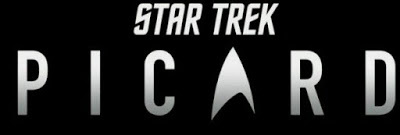 Created for the American video-on-demand service CBS All Access (don’t be fooled by Amazon claiming it as an “Original” here in the UK and in other territories - they just have the rights to stream it internationally),
Star Trek
’s seventh live-action series is unique in that it is built around a single character, as opposed to an entire crew. As much a vehicle for Sir Patrick Stewart as it is the once redoubtable Captain Jean-Luc Picard, this clumsily-named show revisits the revered character on the eve of the twenty-fifth century, almost twenty years on from the tragic events of 2002’s Star Trek: Nemesis and more than a decade after the disastrous supernova that destroyed the Romulan Empire in JJ Abrams’ lauded 2009 Trek movie. These two events, or at least their repercussions, have effectively broken the former Enterprise captain, leaving him “waiting to die” on his family’s vineyard in La Barre alongside a pair of asylum-seeking Romulan intelligence operatives who now appear to be as close to him as the crew of Starfleet’s famous flagship once were.
Created for the American video-on-demand service CBS All Access (don’t be fooled by Amazon claiming it as an “Original” here in the UK and in other territories - they just have the rights to stream it internationally),
Star Trek
’s seventh live-action series is unique in that it is built around a single character, as opposed to an entire crew. As much a vehicle for Sir Patrick Stewart as it is the once redoubtable Captain Jean-Luc Picard, this clumsily-named show revisits the revered character on the eve of the twenty-fifth century, almost twenty years on from the tragic events of 2002’s Star Trek: Nemesis and more than a decade after the disastrous supernova that destroyed the Romulan Empire in JJ Abrams’ lauded 2009 Trek movie. These two events, or at least their repercussions, have effectively broken the former Enterprise captain, leaving him “waiting to die” on his family’s vineyard in La Barre alongside a pair of asylum-seeking Romulan intelligence operatives who now appear to be as close to him as the crew of Starfleet’s famous flagship once were.

Patrick Stewart’s portrayal of an elderly, embittered Picard is profoundly upsetting on a number of levels – just as it should be. When I think back to my childhood and adolescence, popular culture was bursting at the seams with young anti-heroes; just and noble leaders in the Optimus Prime / Jean-Luc Picard mould were few and far between, making them all the more precious. Yet Stewart reportedly had little interest in reviving the inspirational Picard that we’ve all loved and respected for decades, instead preferring to use the Trek platform to shine a “reforming light” on “these often very dark times.” This, it has to be said, Stewart does magnificently.

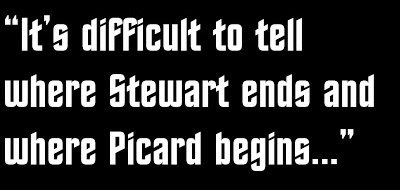 “Remembrance,” the show’s first episode, brings the audience instantly up to speed on where the retired admiral stands through an ill-judged media appearance that probes the controversial circumstances surrounding his departure from Starfleet. It’s difficult to tell where Stewart ends and where Picard begins as the actor pours every ounce of his well-documented political frustrations into a tirade that denounces Starfleet’s callous behaviour towards Romulan refugees, the Federation’s increasingly insular foreign policy and its outlawing of synthetic lifeforms. Yet in a marvellous masterstroke, Stewart and his seven co-executive producers (watch that beautiful, drawn-out title sequence and count ’em all) then proceed to lift the veil on a man who has seemingly become the very thing that he speaks out against. The isolationism and indifference of the Federation is mirrored in the once great man who’s cut himself off from the rest of the universe and surrendered the last vestiges of his once paramount sense of duty.
“Remembrance,” the show’s first episode, brings the audience instantly up to speed on where the retired admiral stands through an ill-judged media appearance that probes the controversial circumstances surrounding his departure from Starfleet. It’s difficult to tell where Stewart ends and where Picard begins as the actor pours every ounce of his well-documented political frustrations into a tirade that denounces Starfleet’s callous behaviour towards Romulan refugees, the Federation’s increasingly insular foreign policy and its outlawing of synthetic lifeforms. Yet in a marvellous masterstroke, Stewart and his seven co-executive producers (watch that beautiful, drawn-out title sequence and count ’em all) then proceed to lift the veil on a man who has seemingly become the very thing that he speaks out against. The isolationism and indifference of the Federation is mirrored in the once great man who’s cut himself off from the rest of the universe and surrendered the last vestiges of his once paramount sense of duty.
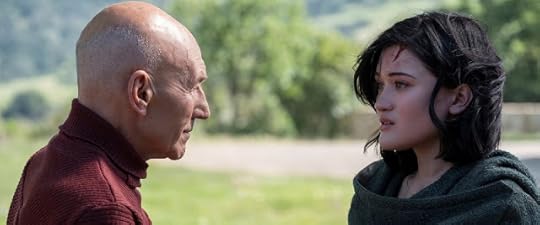
However, whilst the plot of “Remembrance” is certainly full of surprises, the direction of the series is quick to take shape as a desperate young woman (Isa Briones) seeks out the retired admiral, forcing him out of his self-imposed and self-pitying exile. No, we don’t like who Picard has become. Yes, it hurts to see Roddenberry’s perfect future torn down. There, we have a foundation for a thrilling story that will doubtless culminate in the rewarding restoration of both. Before we shed a tear for the loss of “our” Picard, we should remember that television has evolved considerably since the episodic syndication of TNG – the serialised storytelling that has evolved alongside video-on-demand platforms allows us to take characters, and even organisations as large as the United Federation of Planets, from A to B, enjoying all the gripping drama along the way, as opposed to just presenting us with B and telling stand-alone stories of limited scope.
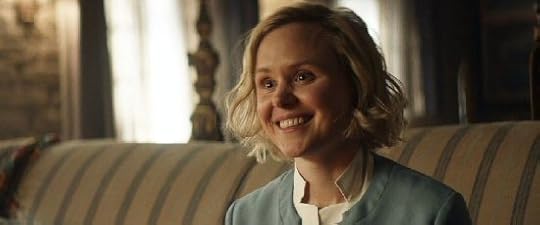
Where I’m struggling a little with the series though is in its uneven approach towards continuity. Unlike the first season of Star Trek: Discovery , which really did a number on Klingon physiognomy and culture as it put the needs of the moment ahead of respect for the past, Picard instead treats the events of TNG and its four movies with great reverence, even going so far as to incorporate a lovely little bit of business to explain why some Romulans look like Eric Bana’s Nero in the 2009 movie while others look more like those seen throughout TNG and in Nemesis. Picard does far more than just learn from Discovery’s mistakes, though: it turns to the legacy of TNG for the very cornerstones of its plot and their emotional underpinning. Unfortunately, this engenders a sense of expectation in those intimately familiar with TNG which is not always paid off satisfactorily. The central positioning of characters like Bruce Maddox, who appeared in just one TNG episode and was Data’s absent pen pal in another, seems to point squarely towards a twist that is then squandered when the provenance of Isa Briones’ character is revealed. To misquote Breaking Bad , the writers use a half-measure when I was expecting them to use a full-measure. Such matters won’t trouble new viewers, of course, but for those like me with pre-existing knowledge of TNG, Picard can prove to be quite bewildering at times.
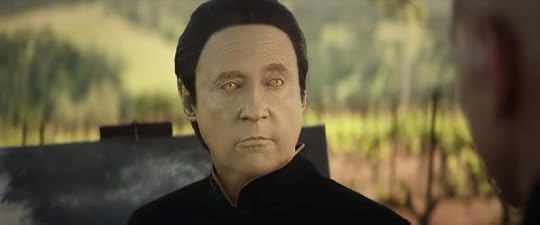
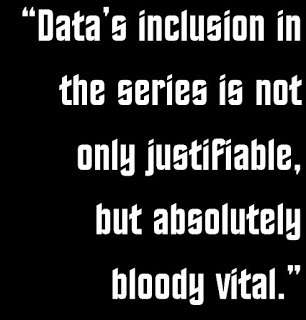 Fortunately, so far Picard has got everything that really matters right – even those things that I was convinced would trip it up. With its trailers focusing quite heavily on the Enterprise’s once resident android, I was concerned that Data’s sacrifice in Nemesis would be debased in the same way that Spock’s dignified demise in Star Trek II: The Wrath of Khan ultimately was. With shots of Picard and Jurati considering Soong-type android body parts slipped in amongst clips of Picard and Data conversing in the present day, the probability of the Enterprise’s second officer’s sensational resurrection seemed high. However, while it’s far too early in the season to rule out such a move entirely, Picard instead seems to be continuing Data’s memorable TNG journey in a much wilier way – one that preserves the emotional resonance of Data’s death while also allowing the show to progress the moral dilemma first posed by “The Measure of a Man” and thrill audiences old and new with a slick and enthralling techno-thriller. As such, Data’s inclusion in the series is not only justifiable, but absolutely bloody vital.
Fortunately, so far Picard has got everything that really matters right – even those things that I was convinced would trip it up. With its trailers focusing quite heavily on the Enterprise’s once resident android, I was concerned that Data’s sacrifice in Nemesis would be debased in the same way that Spock’s dignified demise in Star Trek II: The Wrath of Khan ultimately was. With shots of Picard and Jurati considering Soong-type android body parts slipped in amongst clips of Picard and Data conversing in the present day, the probability of the Enterprise’s second officer’s sensational resurrection seemed high. However, while it’s far too early in the season to rule out such a move entirely, Picard instead seems to be continuing Data’s memorable TNG journey in a much wilier way – one that preserves the emotional resonance of Data’s death while also allowing the show to progress the moral dilemma first posed by “The Measure of a Man” and thrill audiences old and new with a slick and enthralling techno-thriller. As such, Data’s inclusion in the series is not only justifiable, but absolutely bloody vital.
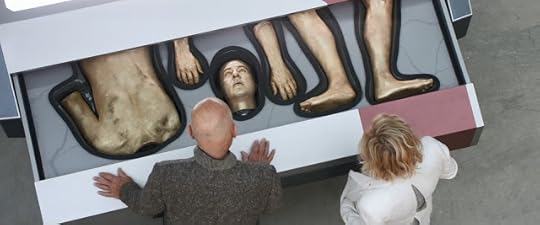
Nonetheless, though the dearly departed Data is the story’s main catalyst and we have both Jonathan Frakes (who directed the show’s upcoming brace of episodes) and Marina Sirtis ( Titans , The Orville ) waiting in the wings for cameos, Picard is not a TNG reunion show. Instead, the Enterprise captain is aided in his mission by a motley crew of outcasts and misfits, many of whom don’t seem to have got the memo about this being a one-man show, such is their screen presence. Alison Pill’s affable Dr Agnes Jurati, a synthetic researcher at the Daystrom Institute in Okinawa, has been already made the leap from exposition to entertainment, while Orla Brady and Jamie McShane’s Romulan housekeepers vest the first three episodes with a TNG-like sense of camaraderie. Brady’s Laris is one of the show’s standouts, particularly in “Maps and Legends” (there must be an REM fan on the writing staff…), and her failure to join the former Starfleet captain on his endeavour has been one of my few disappointments with the programme to date.

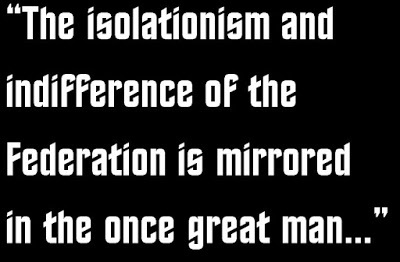 “The End is the Beginning”, this week’s instalment, solidifies both as Captain Cristóbal Rios and Raffi Musiker as key members of the ensemble, though there is clearly no sense of comradeship here – at least initially. Both of these characters subvert the enduring image of the beyond-reproach Starfleet officer but, crucially, without compromising their ethics. Indeed, the show implies that it was their integrity that led each of them down dark paths leading to, in Raffi’s case, substance dependency, and in Rios’s, a life of crime and superficial recklessness that Picard sees straight through. These characters’ demons only seem to make them more real, and perhaps more identifiable - they aren’t less, but more.
“The End is the Beginning”, this week’s instalment, solidifies both as Captain Cristóbal Rios and Raffi Musiker as key members of the ensemble, though there is clearly no sense of comradeship here – at least initially. Both of these characters subvert the enduring image of the beyond-reproach Starfleet officer but, crucially, without compromising their ethics. Indeed, the show implies that it was their integrity that led each of them down dark paths leading to, in Raffi’s case, substance dependency, and in Rios’s, a life of crime and superficial recklessness that Picard sees straight through. These characters’ demons only seem to make them more real, and perhaps more identifiable - they aren’t less, but more.
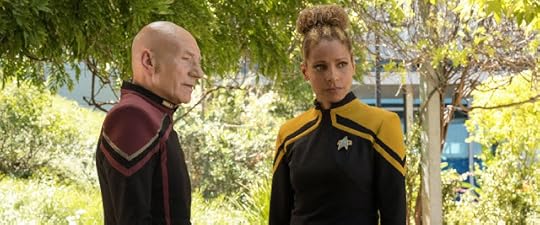
The opening scenes of “The End is the Beginning”, which take us back to the day that Picard resigned his Starfleet commission, are incredibly powerful - Michelle Hurd and Patrick Stewart are quick to conjure the trust and conviviality of the Riker / Picard relationship, only for it to crumble when the arrogant admiral’s failed gambit drags his aide down with him. Rios’s backstory has only been hinted at as I write this, but as he’s a man whose only companions are emergency holograms wearing his own face, he seems to fulfil the show’s prerequisite for loneliness and disillusionment while also providing viewers with some much-needed comedy - Santiago Cabrera evidently revels in creating distinctly different holographic versions of his character, each of which betrays an aspect of spirit buried beneath that simmering Han Solo exterior.
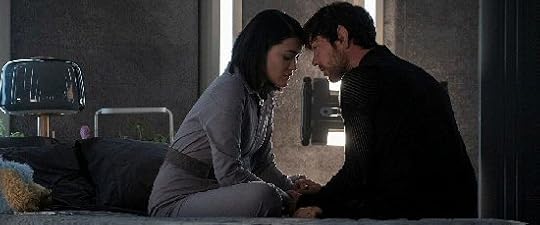
While Picard has been assembling his new crew, though, his quarry waits for him aboard an abandoned Borg cube - the Artefact – which is ostensibly under Romulan control despite its scientific operations being overseen by the former Borg drone Hugh (Jonathan Del Arco from the TNG episodes “I, Borg” and “Descent, Part II”). Body horror and surrealism combine in a narrative that challenges everything we think we know about androids, the Borg and especially the Romulans. The series has done a remarkable job of taking this often-explored race - TNG’s only consistent big bad, if truth be told - and fleshing out their post-supernova culture in the most beguiling of ways. What’s especially interesting about Picard’s approach to the Romulans is that its focus isn’t just limited to their present – the writers effectively reinvent Romulan mythology here, layering beneath it a secret and sinister loathing of synthetic life that alters how we perceive even long-standing organisations like the Tal Shiar. The extremist Zhat Vash faction is particularly intriguing, particularly as we have the alluring good cop/bad cop team of Harry Treadaway and Peyton List ( Gotham ’s Poison Ivy) following the same trail of breadcrumbs as Picard and his team aboard La Sirena. In a beautiful inversion of the classic trope, the female sibling relies upon acid-blasting shock troopers while the male employs seduction, yet both offer us a fascinating insight into an aspect of Romulan culture previously unseen.
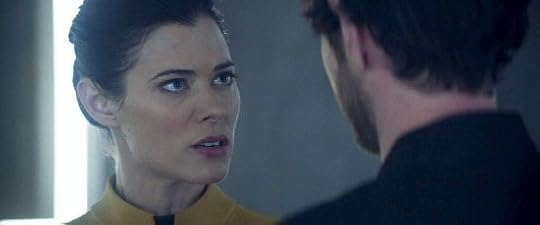
Needless to say, like Discovery, Picard is a relentless visual and auditory feast. The look of 2399 strikes a pleasing balance between the idiosyncratic stylistics of TNG and the modern elegance of Discovery, as exemplified by the stunningly redolent Starfleet uniforms. Château Picard feels altogether more tangible than it ever did in TNG, and the series’ visual effects are, with the possible exception of just one or two ropey Starfleet Headquarters establishing shots, top-notch. Even the cinematography is stunning, with the show offering Abrams-like flourishes in certain shots but still embracing classic, natural beauty. Sadly though, the streaming presentation is limited to 1080p worldwide, which is tremendously disappointing given the series’ high profile. With Picard having been shot using anamorphic lenses (sheer fucking hubris - it’s made for television, not movie theatres!), this effectively leaves those of us who can’t stand letterboxing and have to zoom in with an 800-pixel-high image, which is scarcely better than 720p - thirty-year-old TNG episodes provide sharper resolution than that. I don’t know whether Discovery and Picard have been finished in 4K, but even 4K upscales with HDR would be preferable to the industry standard of fifteen years ago. Sadly, as both seasons of Discovery have already had Blu-ray releases, with no word on 4K UHD sets, 4K Trek releases seem unlikely - at least in the foreseeable future.
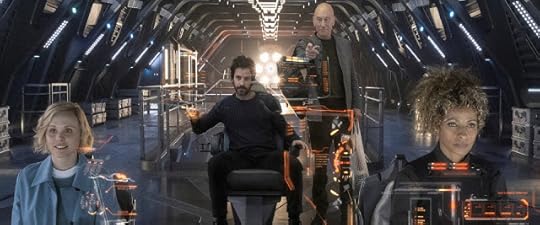
Inevitably, Star Trek: Picard isn’t going to everybody’s cup of earl grey. Whilst aspirational in its ideals, the franchise has seldom been actively political, inspiring change through example rather than allegory, and as such Picard makes for a much edgier Trek than viewers might be prepared for. However, for those who need their Picard caffeinated, there’s still an entire alternative future for him out there in print – one where Riker outranks him, Beverly Crusher has given him a son and Data lives again, but the man himself remains inviolate. Picard’s world-weary interpretation of the former Enterprise captain is altogether more interesting from my viewpoint, though, and I can’t wait to see where his adventure takes us next. Engage...
Star Trek: Picard’s first three episodes are available to stream now in the UK on Amazon Prime Video, with the remaining seven following each Friday until the season concludes 27th March 2020. You can start a 30-day free trial by signing up here (and if you’re only planning to watch Picard, you might want to hold fire until at least 27th February 2020 to make sure you can watch the whole thing).

A single line from Star Trek: Picard’s first episode succinctly summarises its spirit. If Star Trek: The Next Generation (“TNG”) was a lovely dream, “too convivial, too sterile, and too light-hearted” to tempt its leading man to ever reprise his iconic role, then Star Trek: Picard is an indignant reminder to us all that humanity is still light years away from Gene Roddenberry’s utopia. Even once we’ve achieved Roddenberry’s idyllic future, it seems, the struggle to maintain it in the face of catastrophe and grief is sometimes too much for even the best of us.

 Created for the American video-on-demand service CBS All Access (don’t be fooled by Amazon claiming it as an “Original” here in the UK and in other territories - they just have the rights to stream it internationally),
Star Trek
’s seventh live-action series is unique in that it is built around a single character, as opposed to an entire crew. As much a vehicle for Sir Patrick Stewart as it is the once redoubtable Captain Jean-Luc Picard, this clumsily-named show revisits the revered character on the eve of the twenty-fifth century, almost twenty years on from the tragic events of 2002’s Star Trek: Nemesis and more than a decade after the disastrous supernova that destroyed the Romulan Empire in JJ Abrams’ lauded 2009 Trek movie. These two events, or at least their repercussions, have effectively broken the former Enterprise captain, leaving him “waiting to die” on his family’s vineyard in La Barre alongside a pair of asylum-seeking Romulan intelligence operatives who now appear to be as close to him as the crew of Starfleet’s famous flagship once were.
Created for the American video-on-demand service CBS All Access (don’t be fooled by Amazon claiming it as an “Original” here in the UK and in other territories - they just have the rights to stream it internationally),
Star Trek
’s seventh live-action series is unique in that it is built around a single character, as opposed to an entire crew. As much a vehicle for Sir Patrick Stewart as it is the once redoubtable Captain Jean-Luc Picard, this clumsily-named show revisits the revered character on the eve of the twenty-fifth century, almost twenty years on from the tragic events of 2002’s Star Trek: Nemesis and more than a decade after the disastrous supernova that destroyed the Romulan Empire in JJ Abrams’ lauded 2009 Trek movie. These two events, or at least their repercussions, have effectively broken the former Enterprise captain, leaving him “waiting to die” on his family’s vineyard in La Barre alongside a pair of asylum-seeking Romulan intelligence operatives who now appear to be as close to him as the crew of Starfleet’s famous flagship once were.
Patrick Stewart’s portrayal of an elderly, embittered Picard is profoundly upsetting on a number of levels – just as it should be. When I think back to my childhood and adolescence, popular culture was bursting at the seams with young anti-heroes; just and noble leaders in the Optimus Prime / Jean-Luc Picard mould were few and far between, making them all the more precious. Yet Stewart reportedly had little interest in reviving the inspirational Picard that we’ve all loved and respected for decades, instead preferring to use the Trek platform to shine a “reforming light” on “these often very dark times.” This, it has to be said, Stewart does magnificently.

 “Remembrance,” the show’s first episode, brings the audience instantly up to speed on where the retired admiral stands through an ill-judged media appearance that probes the controversial circumstances surrounding his departure from Starfleet. It’s difficult to tell where Stewart ends and where Picard begins as the actor pours every ounce of his well-documented political frustrations into a tirade that denounces Starfleet’s callous behaviour towards Romulan refugees, the Federation’s increasingly insular foreign policy and its outlawing of synthetic lifeforms. Yet in a marvellous masterstroke, Stewart and his seven co-executive producers (watch that beautiful, drawn-out title sequence and count ’em all) then proceed to lift the veil on a man who has seemingly become the very thing that he speaks out against. The isolationism and indifference of the Federation is mirrored in the once great man who’s cut himself off from the rest of the universe and surrendered the last vestiges of his once paramount sense of duty.
“Remembrance,” the show’s first episode, brings the audience instantly up to speed on where the retired admiral stands through an ill-judged media appearance that probes the controversial circumstances surrounding his departure from Starfleet. It’s difficult to tell where Stewart ends and where Picard begins as the actor pours every ounce of his well-documented political frustrations into a tirade that denounces Starfleet’s callous behaviour towards Romulan refugees, the Federation’s increasingly insular foreign policy and its outlawing of synthetic lifeforms. Yet in a marvellous masterstroke, Stewart and his seven co-executive producers (watch that beautiful, drawn-out title sequence and count ’em all) then proceed to lift the veil on a man who has seemingly become the very thing that he speaks out against. The isolationism and indifference of the Federation is mirrored in the once great man who’s cut himself off from the rest of the universe and surrendered the last vestiges of his once paramount sense of duty. 
However, whilst the plot of “Remembrance” is certainly full of surprises, the direction of the series is quick to take shape as a desperate young woman (Isa Briones) seeks out the retired admiral, forcing him out of his self-imposed and self-pitying exile. No, we don’t like who Picard has become. Yes, it hurts to see Roddenberry’s perfect future torn down. There, we have a foundation for a thrilling story that will doubtless culminate in the rewarding restoration of both. Before we shed a tear for the loss of “our” Picard, we should remember that television has evolved considerably since the episodic syndication of TNG – the serialised storytelling that has evolved alongside video-on-demand platforms allows us to take characters, and even organisations as large as the United Federation of Planets, from A to B, enjoying all the gripping drama along the way, as opposed to just presenting us with B and telling stand-alone stories of limited scope.

Where I’m struggling a little with the series though is in its uneven approach towards continuity. Unlike the first season of Star Trek: Discovery , which really did a number on Klingon physiognomy and culture as it put the needs of the moment ahead of respect for the past, Picard instead treats the events of TNG and its four movies with great reverence, even going so far as to incorporate a lovely little bit of business to explain why some Romulans look like Eric Bana’s Nero in the 2009 movie while others look more like those seen throughout TNG and in Nemesis. Picard does far more than just learn from Discovery’s mistakes, though: it turns to the legacy of TNG for the very cornerstones of its plot and their emotional underpinning. Unfortunately, this engenders a sense of expectation in those intimately familiar with TNG which is not always paid off satisfactorily. The central positioning of characters like Bruce Maddox, who appeared in just one TNG episode and was Data’s absent pen pal in another, seems to point squarely towards a twist that is then squandered when the provenance of Isa Briones’ character is revealed. To misquote Breaking Bad , the writers use a half-measure when I was expecting them to use a full-measure. Such matters won’t trouble new viewers, of course, but for those like me with pre-existing knowledge of TNG, Picard can prove to be quite bewildering at times.

 Fortunately, so far Picard has got everything that really matters right – even those things that I was convinced would trip it up. With its trailers focusing quite heavily on the Enterprise’s once resident android, I was concerned that Data’s sacrifice in Nemesis would be debased in the same way that Spock’s dignified demise in Star Trek II: The Wrath of Khan ultimately was. With shots of Picard and Jurati considering Soong-type android body parts slipped in amongst clips of Picard and Data conversing in the present day, the probability of the Enterprise’s second officer’s sensational resurrection seemed high. However, while it’s far too early in the season to rule out such a move entirely, Picard instead seems to be continuing Data’s memorable TNG journey in a much wilier way – one that preserves the emotional resonance of Data’s death while also allowing the show to progress the moral dilemma first posed by “The Measure of a Man” and thrill audiences old and new with a slick and enthralling techno-thriller. As such, Data’s inclusion in the series is not only justifiable, but absolutely bloody vital.
Fortunately, so far Picard has got everything that really matters right – even those things that I was convinced would trip it up. With its trailers focusing quite heavily on the Enterprise’s once resident android, I was concerned that Data’s sacrifice in Nemesis would be debased in the same way that Spock’s dignified demise in Star Trek II: The Wrath of Khan ultimately was. With shots of Picard and Jurati considering Soong-type android body parts slipped in amongst clips of Picard and Data conversing in the present day, the probability of the Enterprise’s second officer’s sensational resurrection seemed high. However, while it’s far too early in the season to rule out such a move entirely, Picard instead seems to be continuing Data’s memorable TNG journey in a much wilier way – one that preserves the emotional resonance of Data’s death while also allowing the show to progress the moral dilemma first posed by “The Measure of a Man” and thrill audiences old and new with a slick and enthralling techno-thriller. As such, Data’s inclusion in the series is not only justifiable, but absolutely bloody vital.
Nonetheless, though the dearly departed Data is the story’s main catalyst and we have both Jonathan Frakes (who directed the show’s upcoming brace of episodes) and Marina Sirtis ( Titans , The Orville ) waiting in the wings for cameos, Picard is not a TNG reunion show. Instead, the Enterprise captain is aided in his mission by a motley crew of outcasts and misfits, many of whom don’t seem to have got the memo about this being a one-man show, such is their screen presence. Alison Pill’s affable Dr Agnes Jurati, a synthetic researcher at the Daystrom Institute in Okinawa, has been already made the leap from exposition to entertainment, while Orla Brady and Jamie McShane’s Romulan housekeepers vest the first three episodes with a TNG-like sense of camaraderie. Brady’s Laris is one of the show’s standouts, particularly in “Maps and Legends” (there must be an REM fan on the writing staff…), and her failure to join the former Starfleet captain on his endeavour has been one of my few disappointments with the programme to date.

 “The End is the Beginning”, this week’s instalment, solidifies both as Captain Cristóbal Rios and Raffi Musiker as key members of the ensemble, though there is clearly no sense of comradeship here – at least initially. Both of these characters subvert the enduring image of the beyond-reproach Starfleet officer but, crucially, without compromising their ethics. Indeed, the show implies that it was their integrity that led each of them down dark paths leading to, in Raffi’s case, substance dependency, and in Rios’s, a life of crime and superficial recklessness that Picard sees straight through. These characters’ demons only seem to make them more real, and perhaps more identifiable - they aren’t less, but more.
“The End is the Beginning”, this week’s instalment, solidifies both as Captain Cristóbal Rios and Raffi Musiker as key members of the ensemble, though there is clearly no sense of comradeship here – at least initially. Both of these characters subvert the enduring image of the beyond-reproach Starfleet officer but, crucially, without compromising their ethics. Indeed, the show implies that it was their integrity that led each of them down dark paths leading to, in Raffi’s case, substance dependency, and in Rios’s, a life of crime and superficial recklessness that Picard sees straight through. These characters’ demons only seem to make them more real, and perhaps more identifiable - they aren’t less, but more.
The opening scenes of “The End is the Beginning”, which take us back to the day that Picard resigned his Starfleet commission, are incredibly powerful - Michelle Hurd and Patrick Stewart are quick to conjure the trust and conviviality of the Riker / Picard relationship, only for it to crumble when the arrogant admiral’s failed gambit drags his aide down with him. Rios’s backstory has only been hinted at as I write this, but as he’s a man whose only companions are emergency holograms wearing his own face, he seems to fulfil the show’s prerequisite for loneliness and disillusionment while also providing viewers with some much-needed comedy - Santiago Cabrera evidently revels in creating distinctly different holographic versions of his character, each of which betrays an aspect of spirit buried beneath that simmering Han Solo exterior.

While Picard has been assembling his new crew, though, his quarry waits for him aboard an abandoned Borg cube - the Artefact – which is ostensibly under Romulan control despite its scientific operations being overseen by the former Borg drone Hugh (Jonathan Del Arco from the TNG episodes “I, Borg” and “Descent, Part II”). Body horror and surrealism combine in a narrative that challenges everything we think we know about androids, the Borg and especially the Romulans. The series has done a remarkable job of taking this often-explored race - TNG’s only consistent big bad, if truth be told - and fleshing out their post-supernova culture in the most beguiling of ways. What’s especially interesting about Picard’s approach to the Romulans is that its focus isn’t just limited to their present – the writers effectively reinvent Romulan mythology here, layering beneath it a secret and sinister loathing of synthetic life that alters how we perceive even long-standing organisations like the Tal Shiar. The extremist Zhat Vash faction is particularly intriguing, particularly as we have the alluring good cop/bad cop team of Harry Treadaway and Peyton List ( Gotham ’s Poison Ivy) following the same trail of breadcrumbs as Picard and his team aboard La Sirena. In a beautiful inversion of the classic trope, the female sibling relies upon acid-blasting shock troopers while the male employs seduction, yet both offer us a fascinating insight into an aspect of Romulan culture previously unseen.

Needless to say, like Discovery, Picard is a relentless visual and auditory feast. The look of 2399 strikes a pleasing balance between the idiosyncratic stylistics of TNG and the modern elegance of Discovery, as exemplified by the stunningly redolent Starfleet uniforms. Château Picard feels altogether more tangible than it ever did in TNG, and the series’ visual effects are, with the possible exception of just one or two ropey Starfleet Headquarters establishing shots, top-notch. Even the cinematography is stunning, with the show offering Abrams-like flourishes in certain shots but still embracing classic, natural beauty. Sadly though, the streaming presentation is limited to 1080p worldwide, which is tremendously disappointing given the series’ high profile. With Picard having been shot using anamorphic lenses (sheer fucking hubris - it’s made for television, not movie theatres!), this effectively leaves those of us who can’t stand letterboxing and have to zoom in with an 800-pixel-high image, which is scarcely better than 720p - thirty-year-old TNG episodes provide sharper resolution than that. I don’t know whether Discovery and Picard have been finished in 4K, but even 4K upscales with HDR would be preferable to the industry standard of fifteen years ago. Sadly, as both seasons of Discovery have already had Blu-ray releases, with no word on 4K UHD sets, 4K Trek releases seem unlikely - at least in the foreseeable future.

Inevitably, Star Trek: Picard isn’t going to everybody’s cup of earl grey. Whilst aspirational in its ideals, the franchise has seldom been actively political, inspiring change through example rather than allegory, and as such Picard makes for a much edgier Trek than viewers might be prepared for. However, for those who need their Picard caffeinated, there’s still an entire alternative future for him out there in print – one where Riker outranks him, Beverly Crusher has given him a son and Data lives again, but the man himself remains inviolate. Picard’s world-weary interpretation of the former Enterprise captain is altogether more interesting from my viewpoint, though, and I can’t wait to see where his adventure takes us next. Engage...
Star Trek: Picard’s first three episodes are available to stream now in the UK on Amazon Prime Video, with the remaining seven following each Friday until the season concludes 27th March 2020. You can start a 30-day free trial by signing up here (and if you’re only planning to watch Picard, you might want to hold fire until at least 27th February 2020 to make sure you can watch the whole thing).

Published on February 07, 2020 23:34
February 2, 2020
TV Review | Doctor Who: “Praxeus” by Pete McTighe & Chris Chibnall
 After the exhilaration of last week’s “Fugitive of the Judoon”, it would have been back to business as (un)usual for
Doctor Who
last night, were it not for the heavily sensationalised outbreak of a new coronavirus strain that casts Pete McTighe and Chris Chibnall’s biochemical thriller in an eerily providential light. The same uncomfortable scheduling that saw the series’ “activation” of a new Doctor follow just days after a very similar scene involving an android in Star Trek: Picard strikes again here as a new pathogen kills both on screen and off.
After the exhilaration of last week’s “Fugitive of the Judoon”, it would have been back to business as (un)usual for
Doctor Who
last night, were it not for the heavily sensationalised outbreak of a new coronavirus strain that casts Pete McTighe and Chris Chibnall’s biochemical thriller in an eerily providential light. The same uncomfortable scheduling that saw the series’ “activation” of a new Doctor follow just days after a very similar scene involving an android in Star Trek: Picard strikes again here as a new pathogen kills both on screen and off.Even without accounting for its serendipitously terrifying timing, “Praxeus” still stands out as one of the most troubling episodes in recent memory. Most people worry about climate change or nuclear war as potential extinction-level events, and with good reason, but, as writers of science fiction have been espousing ever since the invention of the genre, a virus could just as effectively decimate humanity, and it could do so in a way that’s altogether more alarming. We’d have nobody to fight, nobody to blame. McTighe and Chibnall exploit this latent anxiety in the most ghastly of ways as their story sees an intercontinental virus causing people to gruesomely crust over with a crystalline substance before exploding. Scarier still, this virus is carried around the globe by infected birds, the terrifying potential of which has never been fully exploited by the series. As somebody whose wife can’t go near a chicken, let alone suffer any sort of bird flapping around near her, I can see how this episode stokes certain viewers’ ornithophobia in the same way that “Arachnids of the UK” tortured arachnophobes last year.
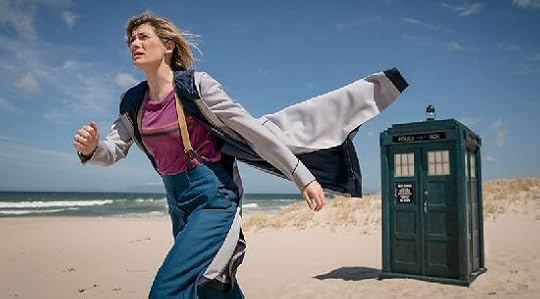

However, what sets Chris Chibnall’s era as showrunner apart from any other is his in-your-face progressive agenda, which in some of his finest episodes elevates what are already superb stories to another level entirely. “Praxeus” might be the best example of this yet as its already two-fold terror is supplanted by the all-too-real creeping fear that we are destroying our world. The blanket bleakness of “Orphan 55” is traded for scary specificity here as Chibnall and McTighe draw inspiration from – and attention to – pollutant gyres. Praxeus might not have evolved on Earth, but the planet’s oceanic garbage patches, with their high saturation of plastic particles, make it the perfect petri dish for an alien race desperate to find a cure. It’s entertaining; it’s educational; and, most importantly, it’s using the programme’s position of influence to try to make a difference to its viewers’ attitudes.
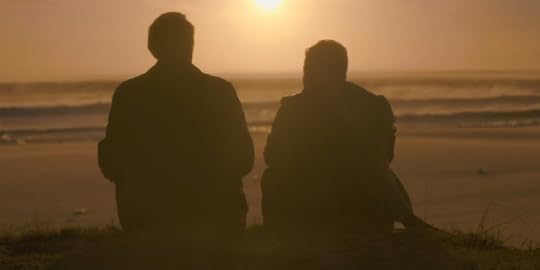
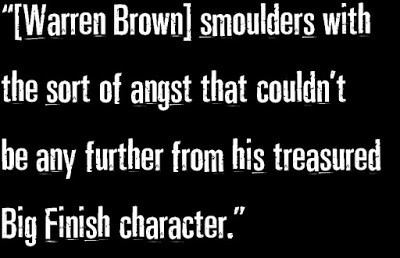 It’s also rather beautiful. With its action convincingly spread across three continents, director Jamie Magnus Stone is able to vest “Praxeus” with the same sort of scope that made
Spyfall
feel like such a momentous event. Visceral moments of primal dread are punctuated by haunting, neon-lit alleyways and magnificent, lingering shots of twilight beaches – the image of Graham and Jake watching the sun set behind the sea lingers just as powerfully as Amaru being engulfed by an unkindness of ferocious diseased birds. Such moments are particularly resonant as this episode’s supporting players are quick to endear themselves the audience - Joana Borja’s vlogger, Gabriela, has all the hallmarks of a potential companion, while dysfunctional married couple Jake and astronaut Adam almost steal the show with their heartbreaking idiocy. Luthor’s Warren Brown is an especially powerful presence as the self-loathing Jake - the Whoniverse veteran smoulders with the sort of angst that couldn’t be any further from his treasured Big Finish character.
It’s also rather beautiful. With its action convincingly spread across three continents, director Jamie Magnus Stone is able to vest “Praxeus” with the same sort of scope that made
Spyfall
feel like such a momentous event. Visceral moments of primal dread are punctuated by haunting, neon-lit alleyways and magnificent, lingering shots of twilight beaches – the image of Graham and Jake watching the sun set behind the sea lingers just as powerfully as Amaru being engulfed by an unkindness of ferocious diseased birds. Such moments are particularly resonant as this episode’s supporting players are quick to endear themselves the audience - Joana Borja’s vlogger, Gabriela, has all the hallmarks of a potential companion, while dysfunctional married couple Jake and astronaut Adam almost steal the show with their heartbreaking idiocy. Luthor’s Warren Brown is an especially powerful presence as the self-loathing Jake - the Whoniverse veteran smoulders with the sort of angst that couldn’t be any further from his treasured Big Finish character.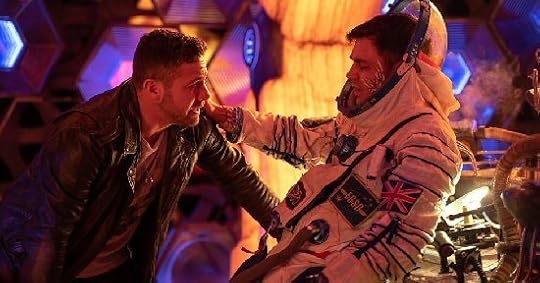
Unfortunately, as with most of the season’s earlier episodes, the TARDIS crew that once dominated narratives are consigned to much smaller roles here. Mandip Gill’s Yasmin enjoys the most focus this week, as the seconded police officer boldly strikes out her own without the Doctor’s knowledge or consent, but poor Graham hasn’t really had much to do at all since taking off his laser shoes and all Tosin Cole’s Ryan seems to do is hit on women or be hit on by them. At times, it’s difficult to believe that this is the same programme that delivered one compelling companion-centred story after another last year, apparently giving the lie to the now all-too-evident truth that even the finest of writers can’t do three companions justice.
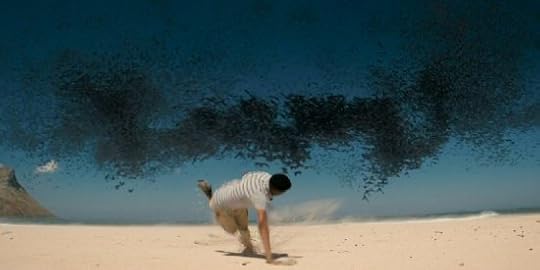
Nonetheless, constantly hopping from Peru to Madagascar to Hong Kong and back again, “Praxeus” is an absolutely stunning piece of television. Jodie Whittaker’s Doctor might not have to grapple with her possible past and potential future this week, but she’s squarely at the centre of the storm throughout, starting a scene in one continent and ending it another without breaking her stride. In what might be a first for the television series, if not the larger Whoniverse, the titular Time Lord isn’t fighting monsters this week, but pathogens and pollutants; the only evils here are those of negligence and apathy.
Doctor Who airs on Sunday evenings on BBC 1 and is available to stream for the foreseeable future on BBC iPlayer . A season pass comprising all ten episodes of the season in 1080p HD and bonus material is also available from iTunes for £20.99, with episodes typically becoming available the day after their transmission on BBC 1. A Blu-ray steelbook is also available to pre-order from Amazon for £49.99.
Published on February 02, 2020 21:47
February 1, 2020
Audiobook Review | Star Wars: Resistance Reborn by Rebecca Roanhorse
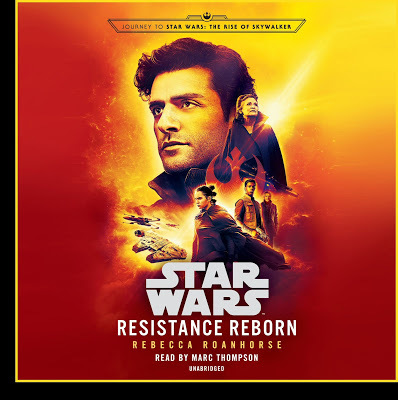 Considering the
Star Wars
timeline which opens each of the Disney-era novels can be quite a sobering experience. With the former Expanded Universe entries long-since torn out and rebranded as “Legends”, all that’s left plugging the gaps between the twelve theatrical Star Wars movies and various TV series are the smattering of novels published since 25th April 2014. Technically speaking, the Marvel comics also form part of the official canon, but even had Del Rey elected to show these on their little infographic, there would still be no escaping the sense that the total sum of canonical Star Wars is now within anyone’s reach. Every book is in print. Every movie and TV show will be streaming on Disney+ by the end of next month. As such, I’m making it my mission to tick off each and every title that I’ve missed since the Disney era began, beginning with, quite appropriately, Rebecca Roanhorse’s recent Resistance Reborn.
Considering the
Star Wars
timeline which opens each of the Disney-era novels can be quite a sobering experience. With the former Expanded Universe entries long-since torn out and rebranded as “Legends”, all that’s left plugging the gaps between the twelve theatrical Star Wars movies and various TV series are the smattering of novels published since 25th April 2014. Technically speaking, the Marvel comics also form part of the official canon, but even had Del Rey elected to show these on their little infographic, there would still be no escaping the sense that the total sum of canonical Star Wars is now within anyone’s reach. Every book is in print. Every movie and TV show will be streaming on Disney+ by the end of next month. As such, I’m making it my mission to tick off each and every title that I’ve missed since the Disney era began, beginning with, quite appropriately, Rebecca Roanhorse’s recent Resistance Reborn.
Spearheading the multimedia Journey to Star Wars: The Rise of Skywalker publishing campaign, Resistance Reborn looks to fill in the blanks between the Battle of Crait and the clearly resurgent Resistance seen at the start of Episode IX . However, this is not a story that spans years or even months – much to her credit, Roanhorse maintains the two preceding films’ tight continuity, picking up the story almost immediately after the survivors’ harrowing escape from Crait and ending only a short time later. Rather than limit itself to being a Labyrinth of Evil -style lead-in, Resistance Reborn instead serves as a springboard for further “Journey to...” tales.
This is not to say that Resistance Reborn isn’t suitably epic in its scope. With numerous narrative threads instead of a Star Wars movie’s usual two or three, Roanhorse’s sprawling story covers more ground than even the busiest entries in the film series. Familiar worlds such as Ryloth and Corellia are explored from fascinating new angles, while the sweeping plot takes us to hitherto unseen worlds the like of Ikkrukk and Ephemera. The author even takes us back to Akiva, where she plucks Wedge Antilles and Norra Wexley from their retirement, before whisking us off to a junkyard planet that might well have been torn out of The Transformers where the First Order schedule captured New Republic ships to be – quite literally - eaten.
However, the real attraction of its novel is Roanhorse’s skilful handling of her large cast of characters. As you might expect, Poe and Leia each feature prominently, which particularly in the former’s case is vital given the gaping chasm between the foolhardy mutineer of The Last Jedi and reliable general of The Rise of Skywalker. No psychological stone is left unturned as Roanhorse tortures her central protagonist with doubts from within and without, not quite turning him into an overnight leader, but certainly giving him an almighty push in the right direction. Leia fares almost as well, particularly in her more introspective moments. She’s the face and heart of the Resistance, but here Roanhorse lets us under the hood, offering us rare insight into how this phenomenal woman gives her every breath in service of her cause despite having suffered what for most people would be insurmountable losses.
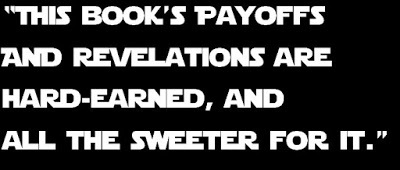 Pleasingly though, Resistance Reborn is large enough to also serve some of the new canon’s secondary characters – players such as the Wexleys, who carried Chuck Wendig’s Aftermath trilogy, as well as many of Poe’s colourful Black Squadron teammates from the Star Wars: Resistance animated series and Marvel comics. Wedge Antilles’ Rise of Skywalker hero moment is given the setup it deserves, Roanhorse taking the character back home to his native Corellia, to memories of his own Imperial cadet days (as seen in
Star Wars Rebels
), as his passion for the cause is rekindled – even if it means having to watch his wife Norra pick up a blaster again. When I read the Aftermath books, it took a long time for me to realise that Norra’s son Temmin would eventually grow up to be the sequel trilogy’s Snap (Greg Grunberg, Heroes), but having read about his troubled youth and watched him fly rings around the First Order on screen, it’s delightful to now catch up with him on a more personal level as he’s tasked with the unenviable task of trying to bring his mother and stepfather back into a fight that will probably mean their deaths.
Pleasingly though, Resistance Reborn is large enough to also serve some of the new canon’s secondary characters – players such as the Wexleys, who carried Chuck Wendig’s Aftermath trilogy, as well as many of Poe’s colourful Black Squadron teammates from the Star Wars: Resistance animated series and Marvel comics. Wedge Antilles’ Rise of Skywalker hero moment is given the setup it deserves, Roanhorse taking the character back home to his native Corellia, to memories of his own Imperial cadet days (as seen in
Star Wars Rebels
), as his passion for the cause is rekindled – even if it means having to watch his wife Norra pick up a blaster again. When I read the Aftermath books, it took a long time for me to realise that Norra’s son Temmin would eventually grow up to be the sequel trilogy’s Snap (Greg Grunberg, Heroes), but having read about his troubled youth and watched him fly rings around the First Order on screen, it’s delightful to now catch up with him on a more personal level as he’s tasked with the unenviable task of trying to bring his mother and stepfather back into a fight that will probably mean their deaths.Perhaps the most surprising aspect of Resistance Reborn, though, is that its most compelling character is also its most abhorrent: Winshur Bratt, the First Order’s executive records officer on Corellia. On screen, the sequels only show us fleeting glimpses of the First Order’s personnel – beyond General Hux and his petty rivalry with Kylo Ren, we know precious little about what they believe in or even what the First Order actually is. Bratt serves as an illicit window into all that – we learn how the First Order controls whole worlds without even having to form a government; how it grooms the most ambitious and morally bankrupt of each planet’s populous for roles that would otherwise have been far above their station. Bratt might at times approach caricature, but Roanhorse offers us enough insight into his thoughts and feelings to really draw the reader into his narrow little world.
The novel also makes good on its promise of rebirth, with its plot ultimately furnishing the Resistance survivors with the tools that they need to rebuild. In the case of hardware, the mission to steal back captured Resistance ships is perhaps a little too convenient for most people’s tastes, but it’s still exhilaratingly executed. The cleverer limb of the story concerns the hunt for allies, and in particular a mission to recover a First Order “most wanted” list that could effectively serve as a guide to every ally the Resistance would ever need. This ties in beautifully with earlier novels, paying off some really quite emotional storylines set in motion a long time ago. I don’t know how far Star Wars literature is mapped out in advance (it can’t be any less planned than the movies), but Resistance Reborn seems to complete its mission with the sort of composure sorely lacking in The Rise of Skywalker. This book’s payoffs and revelations are hard-earned, and all the sweeter for it.
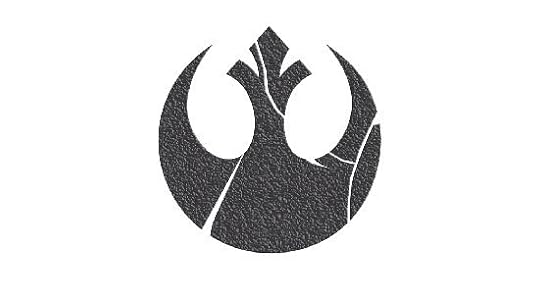
As well as reigniting my own interest in the larger Star Wars universe, Resistance Reborn is also significant for me as it’s my first Star Wars audiobook. As my reading time is presently consumed by Timothy Zahn’s enthralling new Grand Admiral Thrawn trilogy, rather than wait until I’ve finished that, I decided to enjoy Resistance Reborn on the move. Initially, it was a decision I regretted – the Lucasfilm-produced reading is marred by overpowering musical cues and background foley effects; the first chapter was actually painful to endure. Whilst John Williams’ authentic score is sampled, it’s deployed inappropriately throughout – “The Imperial March” is now apparently synonymous with the First Order, for instance, while “Darth Vader’s Death” is used to engender sympathy for a First Order officer’s death and overuse of the moving “Binary Sunset” refrain robs it of any resonance. Worse still, the music has been crudely cut and pasted in, lending the production an amateurish feel. Lucasfilm need to take some tips from Big Finish on how to produce audiobooks. Fortunately the reading is saved by narrator Marc Thompson, whose voice is put through an impressive range of contortions to produce a surprisingly credible portrayal of Poe and a most memorable Winshur Bratt. He even gets a good handle on tricky characters like Rey, Maz and Threepio. The end result is still hardly a stirring success, but it is at least an entertaining enough alternative to reading the book the old-fashioned way.
Though it doesn’t quite have the feel of being a Star Wars movie written down, as other notable lead-in novels have, Resistance Reborn is actually something a little better. All the superficial bells and whistles are there, but where it succeeds is in its substance. If The Rise of Skywalker’s forced twists and painful retcons weren’t for you, then its organic and meticulous prequel might just be.
The Star Wars: Resistance Reborn audiobook is available to download from iTunes for £7.99. Amazon obviously want you to subscribe to their Audible streaming service, in which case you can listen to the audiobook for “free”, as they charge a staggering £22.74 for the download. The CD edition retails for only a little more than that.
Published on February 01, 2020 09:05
January 28, 2020
TV Review | Doctor Who: “Fugitive of the Judoon” by Vinay Patel & Chris Chibnall
 After
Spyfall
’s apparently aberrant shift back towards the show’s past (in both its returning antagonist and some of its stylistic trappings), the subsequent brace of episodes saw
Doctor Who
return to the format of its previous season, cultivating a sense of security that even the well-publicised return of everyone’s favourite trigger-happy space rhinos didn’t seem likely to threaten. My little girl and I were certainly excited by the prospect of her Doctor locking horns with the brutal and bureaucratic Judoon of “Smith and Jones” fame, but neither of us were even remotely prepared for the fist-pumping rollercoaster ride that would begin, of all places, in contemporary Gloucester.
After
Spyfall
’s apparently aberrant shift back towards the show’s past (in both its returning antagonist and some of its stylistic trappings), the subsequent brace of episodes saw
Doctor Who
return to the format of its previous season, cultivating a sense of security that even the well-publicised return of everyone’s favourite trigger-happy space rhinos didn’t seem likely to threaten. My little girl and I were certainly excited by the prospect of her Doctor locking horns with the brutal and bureaucratic Judoon of “Smith and Jones” fame, but neither of us were even remotely prepared for the fist-pumping rollercoaster ride that would begin, of all places, in contemporary Gloucester. Penned in part by the writer of one of last year’s best stories, “Demons of the Punjab”, the only clue as to this episode’s surprising significance is to be found on its title card, which credits Chris Chibnall as Vinay Patel’s writing partner. Indeed, with the exception of the unusually moody and arc-heavy TARDIS scenes, which I had assumed would account for the showrunner’s co-writing credit, the opening of the episode plays very much as expected - the Judoon cordon off the sleepy cathedral city with an enforcement field as they hunt for their eponymous fugitive. The lively and often humorous plot steers viewers squarely towards secretive Bathrooms 4U employee Lee Clayton (Neil Stuke, Game On), while in the background a more likely suspect emerges in the skies above Earth – one who’s trying to scoop the Doctor up onto his ship, and not making a very good job of it. Despite some beautifully sharp dialogue, perfectly pitched performances even some absolutely sumptuous Glostonian visuals from director Nida Manzoor, “Fugitive of the Judoon” initially feels a lot like the routine rhino runaround implicitly promised by its billing.

And then an alien ship speaks with a familiar voice, and what would in any other episode have been the bombshell of the week is dropped as Captain Jack Harkness materialises in front of a baffled Graham. It’s the sensational shot in the arm that the show needed after last week’s relative calm, and John Barrowman milks the moment for all that it’s worth, aided and abetted by Bradley Walsh at his incredulous best. The former Torchwood chief might not look a day older than he did a decade ago (and why should he – he’s immortal), but the Doctor has certainly changed since they last met, and like Stephen Fry’s C before him, Jack inevitably mistakes the Doctor’s eldest companion for his old Time Lord friend. Jack’s ensuing reaction to news of the Doctor’s change of gender is wonderful in its cheeky exuberance – it’s as if all his Christmases have come at once when, in fact, it’s actually the viewers’ Christmases that have arrived en masse. Jack, it seems, it just being a tease – a warning (“The Lone Cyberman… don’t give it what it wants!”) and a promise rolled into one. Viewers barely have time to process their disappointment at having to wait for the inexorable meeting of Jack and the so-called “Thirteenth Doctor” when the episode’s titular fugitive is unmasked as Lee’s seemingly innocuous tour-guide wife Ruth (Jo Martin, Holby City). Having used a chameleon arch to make herself human, this suddenly woken – and, indeed, woke – woman introduces herself as the Doctor. And, with her flamboyant outfit and brassy attitude to match, it’s easy to believe her.
Yet Whittaker’s Doctor has no memory or being her, and vice-versa. More confoundingly still, Martin’s Doctor hails from a time in which Gallifrey and its resident Time Lords are a power in the universe. This immediately suggests that, if she’s legitimate, this new Doctor must either pre-date William Hartnell’s “original” or exist between the Doctor’s purportedly second and third incarnations (as the Patrick Troughton to Jon Pertwee regeneration is the only one that we’ve never been shown) – unless, of course, the Time Lords are either miraculously returned from the dead (again...) or revealed not to be. Remember, the series has only shown us a smoking Citadel and a dead planet. Grim, but hardly concrete evidence of a race’s extermination. However, while the how might be baffling, the fact of the matter seems clear - “Fugitive of the Judoon” goes out of its way to emphasise that Martin’s Doctor is the real deal, as opposed to some clone or parallel-universe iteration. Her brain chemistry matches the Doctor’s exactly. Her identity is verified through Time Lord mind-to-mind contact. Martin is even billed as the Doctor on the programme’s closing credits. Her identity is effectively chiselled in stone.
But I’ve been burned before. When the news of David Tennant’s departure was quickly followed by a Christmas special entitled “The Next Doctor”, fandom was alight with speculation of precisely the sort that is currently lighting up every corner of the Internet. Back then, despite sharing many an adventure with earlier incarnations, a reigning Doctor had never encountered a future self (on television, at least), and so the idea that the show would be bold enough – and prepared enough – to dip into its own future was incredibly tantalising. Unfortunately, David Morrissey’s Doctor proved not to be an illicit glimpse of a future life but a parody of a past one, and whilst Martin’s performance here is, comparatively, a study in seriousness, it is typified by a number of troubling traits that don’t sit well the Doctor’s typical characterisation. Most of the Doctors have been just as ruthless as hers is – Sylvester McCoy’s was a destroyer of worlds, while John Hurt’s warrior incarnation was prepared to commit double genocide in service of a greater good. Even the post-Time War, pre-Jodie Doctors were brutal to their enemies, but they all drew the line at pointing guns at their enemies. There is something very wrong about the image of the Doctor looking down the barrel of a gun at a foe, and Patel and Chibnall really play upon this unease as the incumbent Doctor struggles to reconcile her own self-image with this evident embodiment of her past or future. The creation of Martin’s Doctor is tantalising move, however you look at it, and one that successfully revivifies the Who in Doctor Who for the first time since the show’s anniversary year.
The longer the programme has run, the more difficult it has been for its writers to sustain the mystery of the Doctor. Over the years, different production teams broached the issue in different ways. The intrigue surrounding the character was never greater than when Steven Moffat’s need to fill Christopher Eccleston’s shoes in the fiftieth anniversary special forced him to create Hurt’s forgotten incarnation of the Doctor who’d renounced his name to fight in the Last Great Time War. Ultimately though, the “War Doctor” was not only explained but fully explored – the fleeting sense of mystery conjured by the closing moments of “
Personally, I would be thrilled if Martin’s Doctor turned out to be the original Doctor. Such a move fits best with how she is portrayed in “Fugitive of the Judoon” – Hartnell’s Doctor might have eventually become quite noble, but at the outset he was an irascible kidnapper who was quite prepared to cave in a caveman’s head with a rock if it saved his own skin. There is even enough wiggle room with the Doctor’s initial run of regenerations for this idea to work as, in his hurry to address the restrictive “Time Lords only have thirteen lives” rule arbitrarily imposed by Robert Holmes in The Deadly Assassin before leaving the show, Moffat counted the Doctor’s aborted regeneration in “The Stolen Earth” as one of his allotted twelve. I had no issue with him doing so – it makes perfect sense as it saved the Doctor from that Dalek’s blast as effectively as a new body would have – but, equally, I’d have no issue accepting otherwise if it gave us an exciting new Doctor to explore.
I’m still sceptical though. A forgotten Doctor has not only been done before, but recently and superlatively, and there’s not an actor alive today who could do as fine as job as John Hurt did. Martin’s Doctor hailing from the programme’s relative future would be a much safer but just as stimulating ploy, albeit a ploy much more difficult to pull off - the series would be set on a fixed course which, unless Chibnall and company are über-prepared, would be a logistical nightmare, not to mention potentially very limiting. Moffat didn’t let this stop him throwing Peter Capaldi’s incarnation into “The Day of the Doctor”, of course, though the circumstances there were very different as Matt Smith’s reign was all but over and work was already well underway on Capaldi’s first season. Bringing in a new Doctor now, at least a season and a half early when going by recent lead’s tenures, would be completely unprecedented – and utterly thrilling.
For all its excitement and potentially wide-ranging repercussions, though, “Fugitive of the Judoon” has one rather glaring little weakness, and it’s one that’s becoming something of a worrying trend. We’re now at the season’s half-way point, and only Spyfall has catered for all three companions well. When an episode focuses heavily on the Doctor, as the last couple have, it’s at the expense of her three companions. This episode is the season’s worst example so far as it effectively treats them as one amalgam entity as opposed to three individuals – they’re growing more curious about the Doctor together. They’re getting annoyed with the Doctor together. Sure, Yas has the odd moment in which she can utilise her police background in this episode, just as Graham’s flexed his working man’s wings last week, but there is nothing of substance. Sadly, there just isn’t enough screen time for each character to have a different reaction to this season’s drip-fed revelations, which is incredibly frustrating given how well Chibnall’s first season built up each one of them.
This time last week, I was writing about an episode that I felt destined for obscurity. “Fugitive of the Judoon”, however, is its opposite in almost every meaningful way. It’s either the series’ most significant episode since “The Name of the Doctor”, or its greatest hoax since “The Next Doctor”, but either way it is one that we’re going to be talking about for a long, long time.
Doctor Who airs on Sunday evenings on BBC 1 and is available to stream for the foreseeable future on BBC iPlayer . A season pass comprising all ten episodes of the season in 1080p HD and bonus material is also available from iTunes for £20.99, with episodes typically becoming available the day after their transmission on BBC 1. A Blu-ray steelbook is also available to pre-order from Amazon for £49.99.
Published on January 28, 2020 05:32
January 23, 2020
TV Review | Doctor Who: “Nikola Tesla's Night of Terror” by Nina Métivier
 With its Rotten Tomatoes’ audience score hitting a derisory 13% and its broadcast attracting just 4.04 million viewers, a low not seen since the dark days of
The Trial of a Time Lord
back in 1986, the numbers really don’t look good for “Nikola Tesla's Night of Terror” – which is quite ironic, really, as it’s effectively
Doctor Who
by numbers. Although viewing figures don’t mean anything like what they once did and Rotten Tomatoes is hardly the most reliable gauge of a programme’s reception, The A List’s Nina Métivier’s first script for the series still feels a little underwhelming. Following hot on the heels of the thrilling Spyfall and provocative “Orphan 55”, it has a seemingly inevitable whiff of mediocrity about it that most will struggle to overcome.
With its Rotten Tomatoes’ audience score hitting a derisory 13% and its broadcast attracting just 4.04 million viewers, a low not seen since the dark days of
The Trial of a Time Lord
back in 1986, the numbers really don’t look good for “Nikola Tesla's Night of Terror” – which is quite ironic, really, as it’s effectively
Doctor Who
by numbers. Although viewing figures don’t mean anything like what they once did and Rotten Tomatoes is hardly the most reliable gauge of a programme’s reception, The A List’s Nina Métivier’s first script for the series still feels a little underwhelming. Following hot on the heels of the thrilling Spyfall and provocative “Orphan 55”, it has a seemingly inevitable whiff of mediocrity about it that most will struggle to overcome.Fortunately, “Nikola Tesla's Night of Terror” is often more than just a join-the-dots Doctor Who story. In framing the narrative in the unusual way that she does, Métivier cleverly flips viewers’ perspectives, allowing us to see the Doctor and her gang from the viewpoint of the eponymous futurist. This plays particularly well here as Tesla bucks the well-trodden trend of open-mouthed incomprehension when faced with aliens and technology indistinguishable from magic. What he doesn’t immediately grasp, he theorises about; nothing seems to faze him. Such qualities make him immediately endearing, not just to us watching at home, but evidently to the Doctor too. Jodie Whittaker and Goran Višnjić are suitably electric together – if anything, their characters’ relationship could have been taken further, and I dare say would have been were the genders reversed. David Tennant and Matt Smith’s Doctors were often being kissed for far less.
With the focus so firmly on the Doctor, there’s little room in this episode for her friends to shine, but even so Bradley Walsh manages to enjoy a strong outing as he finds his workplace ethics squarely at odds with Edison’s. Even Ryan’s evolution into something of a player continues as he seems to take an interest in Dorothy Skerritt, much to Yas’s exasperation. However, “Nikola Tesla's Night of Terror” is more of a vehicle for its guest stars, two of whom already have a firm grounding in the Whoniverse. Peter Davison’s old Sink or Swim co-star Robert Glenister, who famously appeared alongside Davison in the fifth Doctor’s stunning swansong The Caves of Androzani , returns to the programme in the guise of Thomas Edison – America’s greatest inventor, and Tesla’s greatest adversary. My little girl was delighted to see the programme taking such a forthright look at a man she’s learning about at school, especially as he’s seen through Tesla’s eyes, offering her a fresh and significantly less favourable take on him to challenge her teacher with.
Meanwhile, the story’s alien menace are given a face by The Sarah Jane Adventures ’ Anjli Mohindra, who serves up her best Sarah Parish impression as the Skithra’s scorpion queen – something that it’s hard to blame her for, given the similarity of the creature’s design to that of the Racnoss queen famously seen in “The Runaway Bride”. Whilst “Nikola Tesla's Night of Terror” might be a lovely character piece, it is sadly let down by its alien antagonists. Racnoss rip-offs and cloaked, lightning-hurling figures are at best unimaginative; at worst so derivative that they border on plagiarism.
Like Tesla himself, “Nikola Tesla's Night of Terror” is no doubt destined for relative obscurity, remembered more for its poor performance than its objective merits. Such a fate is regrettable as while it’s certainly no world-beater, it’s nonetheless an enjoyable and educational episode that ticks all the requisite boxes – and a few more besides.
Doctor Who airs on Sunday evenings on BBC 1 and is available to stream for the foreseeable future on BBC iPlayer . A season pass comprising all ten episodes of the season in 1080p HD and bonus material is also available from iTunes for £20.99, with episodes typically becoming available the day after their transmission on BBC 1. A Blu-ray steelbook is also available to pre-order from Amazon for £49.99.
Published on January 23, 2020 05:14
January 18, 2020
4K Ultra-HD & Blu-ray Review | Watchmen: The Ultimate Cut directed by Zack Snyder

Who watches the Watchmen these days? Well, thanks to HBO’s new spin-off series, probably a few million more than were doing so a few years ago, by which time Zack Snyder's divisive masterwork had begun to fade from recent memory, overshadowed by the MCU juggernaut and DC’s ill-advised attempts to duplicate it. This revival of interest has led to the long-awaited UK release of the movie’s Ultimate Cut on the 4K Ultra-HD format, with Zavvi even offering a luxuriant steelbook version for those prepared to invest a little more.
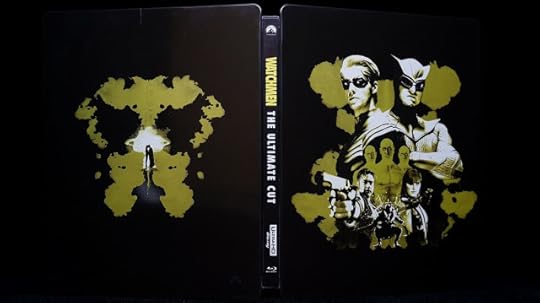 Above: The sold-out-within-hours Zavvi-exclusive steelbook
Above: The sold-out-within-hours Zavvi-exclusive steelbookEven in its theatrical form, Watchmen is one of my favourite comic-book movies – pretty unsurprisingly, really, given that the Watchmen graphic novel is generally regarded as one of the medium’s greatest masterworks and Zack Snyder is one of my favourite directors in the genre. Given his penchant for dark and moody interpretations of even the most colourful of comic-book characters, Watchmen was the ideal fit for Snyder’s subversive style as it came with its cerebral themes and sordid intricacies already in place. All Snyder had to do was stay true to the source material and his own instincts, and the “unfilmable” could finally be filmed.

The Zavvi-exclusive steelbook is extraordinarily striking – a yellow Rorschach ink blot on black steel is the canvas for a colour-drained montage featuring all the principal players. It may not be as iconic as the smiley-face Blu-ray steelbook, but it’s a considerable improvement on the movie poster version that was issued, and it comes jam-packed full of all manner of trivial treats ranging from a blood-spattered smiley sticker to collectible art cards. The steelbook slots safely inside a protective cardboard slipcase that shares the standard release’s artwork, which itself has been very nicely done. The discs themselves are unremarkable, though – picture discs seem to be becoming more and more and thing of the past – but of course it's what on them that really counts.

Like many not-quite-recent films, Watchmen was finished at 2K, which means that its resolution here is only marginally greater than on its 1080p Blu-ray release - the picture has just been upscaled to 2160p. Already abounding with grain, the upscaled image does precious little to enhance what was already a near-perfect presentation. This release doesn’t benefit from a new Atmos or DTS:X soundtrack either - it simply ports over the Blu-ray release’s lossless 5.1 mix. This is not to say that the 4K release isn’t worthwhile, though - the HDR presentation is so drastic as to completely alter the movie’s tone, taking already dark scenes and making them even more atmospheric while allowing the comic book’s deliberately ugly accent colours pop as intended - purples, yellows, magentas and greens appear to be much more vibrant here than on the Blu-ray version (which is also included here in the same curious way that DVDs were bundled with Blu-rays for years).

However, I was less concerned with any uptick in technical quality that this release might offer than with the expanded version of the movie itself. One of Watchmen’s great strengths on the page is the sense of total immersion that it offers - it’s not just a story, but a window into another world; a world with a rich, divergent history that twists everything from the that way war is waged right down to the contents of comic books. Zack Snyder's theatrical cut of Watchmen did a fantastic job of translating the comic book’s narrative into the movie medium, even improving upon its already jaw-dropping final act by making it much more personal, but where I found it wanting was in its absent asides. The flavour of the world conjured by Alan Moore and Dave Gibbons was there, but it was missing its substance. This Ultimate Cut seeks to remedy that, finally putting one of the genre’s most divisive films on the same footing as the graphic novel on which was based.
 Above: Tales of the Black Freighter, present and correct
Above: Tales of the Black Freighter, present and correctWhat sets this Ultimate Cut apart from the Director’s Cut released on home video a decade ago is its seamless assimilation of the Tales of the Black Freighter animation starring Russell Crowe. A dark and impressive piece of work its own right, its inclusion within the main body of the film goes a long way to recapturing the expansive feel of the comic book. Its presence resonates outwards as it draws the audience into the street-level world of Bernard the news vendor and Bernard the comic-book fan while also serving as a grim parallel of Adrian Veidt’s own journey.
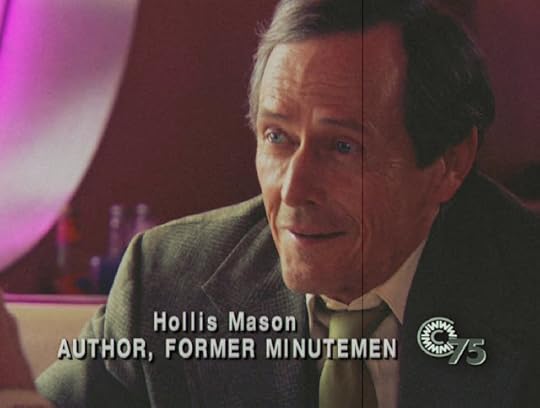 Above: Under the Hood - missing in action
Above: Under the Hood - missing in action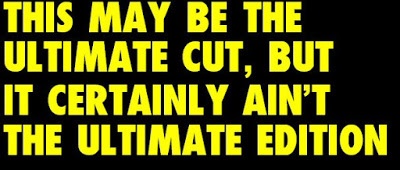 At a mammoth two-hundred and fifteen minutes, this cut of Watchmen is amongst the longest movies that I’ve ever watched, yet I’m still left with the nagging sense that it should have been longer. When Tales of the Black Freighter was released on home video just prior Watchmen’s theatrical run, it was paired with Under the Hood – a forty-minute, faux-documentary that sought to capture the spirit, if not the letter, of the excerpts from the original Nite Owl’s memoir that peppered the pages of the original Watchmen issues. Snyder quite rightly took the view that dramatising Nite Owl’s accounts would have killed their world-building flavour, and so instead he crafted a spoof magazine show entitled The Culpepper Minute on which Nite Owl appears to promote the release of his book. The programme’s central chat sees Nite Owl recount several of the passages published in Watchmen almost verbatim, yet in a manner that doesn’t feel even the slightest bit artificial. Adding colour are brief snippets of interviews with Carla Gugino’s original Silk Spectre and Jeffrey Dean Morgan’s Comedian that instantly bring to life the events that torn the Minutemen apart.
At a mammoth two-hundred and fifteen minutes, this cut of Watchmen is amongst the longest movies that I’ve ever watched, yet I’m still left with the nagging sense that it should have been longer. When Tales of the Black Freighter was released on home video just prior Watchmen’s theatrical run, it was paired with Under the Hood – a forty-minute, faux-documentary that sought to capture the spirit, if not the letter, of the excerpts from the original Nite Owl’s memoir that peppered the pages of the original Watchmen issues. Snyder quite rightly took the view that dramatising Nite Owl’s accounts would have killed their world-building flavour, and so instead he crafted a spoof magazine show entitled The Culpepper Minute on which Nite Owl appears to promote the release of his book. The programme’s central chat sees Nite Owl recount several of the passages published in Watchmen almost verbatim, yet in a manner that doesn’t feel even the slightest bit artificial. Adding colour are brief snippets of interviews with Carla Gugino’s original Silk Spectre and Jeffrey Dean Morgan’s Comedian that instantly bring to life the events that torn the Minutemen apart.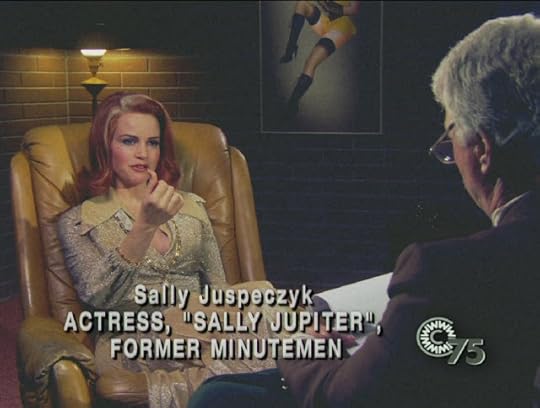 Above: Under the Hood - missing in action
Above: Under the Hood - missing in action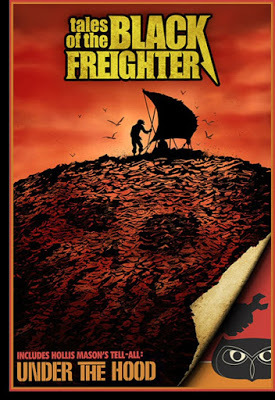 Above: You'll need to hang onto this release for a while yet...In my view Under the Hood is an even more crucial part of the fabric of the Watchmen than Tales of the Black Freighter as it deals directly with the rise and fall of the Minutemen and how this alternative world’s history diverged from our own, and it does so through the beautifully subjective accounts of some of those who lived through it. Admittedly, weaving Under the Hood into the narrative would have been a more challenging task than doing the same for Tales of the Black Freighter – whereas Tales’ colour-dense animation serves as a stark contrast to the murky live-action of the main narrative, Under the Hood is a live-action piece which utilises many of the same players. Yet its period 4:3 aspect ratio, particularly on home video, could have instantly distinguished it from the 2.35:1 main feature, and the footage has already been aged in the same way that later prints of the original book used dot patterns to segregate its Tales of the Black Freighter panels from the main Watchmen panels. Its exclusion from the Ultimate Cut really reeks of missed opportunity.
Above: You'll need to hang onto this release for a while yet...In my view Under the Hood is an even more crucial part of the fabric of the Watchmen than Tales of the Black Freighter as it deals directly with the rise and fall of the Minutemen and how this alternative world’s history diverged from our own, and it does so through the beautifully subjective accounts of some of those who lived through it. Admittedly, weaving Under the Hood into the narrative would have been a more challenging task than doing the same for Tales of the Black Freighter – whereas Tales’ colour-dense animation serves as a stark contrast to the murky live-action of the main narrative, Under the Hood is a live-action piece which utilises many of the same players. Yet its period 4:3 aspect ratio, particularly on home video, could have instantly distinguished it from the 2.35:1 main feature, and the footage has already been aged in the same way that later prints of the original book used dot patterns to segregate its Tales of the Black Freighter panels from the main Watchmen panels. Its exclusion from the Ultimate Cut really reeks of missed opportunity.Leaving Under the Hood out of the Ultimate Cut might have been made a little more palatable had it at least been included in this three-disc set, but sadly the bonus material on offer here is limited to the film’s original complement of special features. This means that Under the Hood is nowhere to be found, nor is the stand-alone cut of Tales of the Black Freighter or even the enlightening twenty-five minute documentary, Story Within a Story, which served as a fascinating exploration of both. This release’s “Ultimate” billing also gave me false hope that I might finally be able to get my hands on a full-HD physical copy of the 2008 Watchmen motion comic, but, again, a corner is cut. In many respects, that motion comic is every bit as gripping as this set’s flagship live-action motion picture.
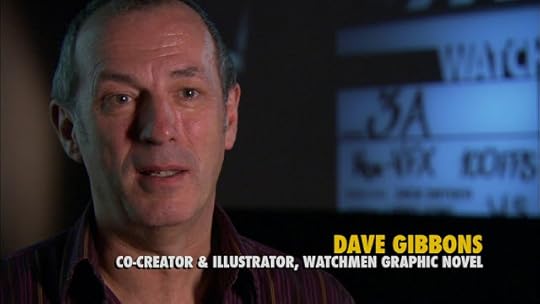 Above: The Phenomenon: The Comic That Changed Comics
Above: The Phenomenon: The Comic That Changed Comics  What has been included, though, is still most impressive. DC and Warner Brothers rarely disappoint in their documentaries, with the depth and quality of their features seeming to increase the more that the focus is turned towards comic books, as opposed to their adaptations. The Phenomenon: The Comic That Changed Comics is a typically comprehensive half-hour retrospective devoted entirely to the creation and reception of Alan Moore and Dave Gibbons' acclaimed graphic novel. Obviously Moore himself doesn’t appear, but Gibbons shares a number of fascinating insights into their collaboration, and a number of DC executives and those involved with the production of the film are on hand to dissect and celebrate what many still hold up as the greatest comic book of all time.
What has been included, though, is still most impressive. DC and Warner Brothers rarely disappoint in their documentaries, with the depth and quality of their features seeming to increase the more that the focus is turned towards comic books, as opposed to their adaptations. The Phenomenon: The Comic That Changed Comics is a typically comprehensive half-hour retrospective devoted entirely to the creation and reception of Alan Moore and Dave Gibbons' acclaimed graphic novel. Obviously Moore himself doesn’t appear, but Gibbons shares a number of fascinating insights into their collaboration, and a number of DC executives and those involved with the production of the film are on hand to dissect and celebrate what many still hold up as the greatest comic book of all time.Real Superheroes: Real Vigilantes is slightly shorter in length, but not substance. Whilst only tangentially linked to Watchmen, their themes marry quite nicely as this piece also challenges the glamorising of have-a-go heroes, taking a sober look at vigilantism with especial focus on New York's Guardian Angels organisation and a pair of real-life superheroes who are as hilarious as they are worrying. Similarly entertaining is the seventeen-minute Mechanics: Technologies of a Fantastic World feature in which Professor James Kakalios – an academic who uses nothing but comic books to teach science classes – discusses the believability of the film’s fantastic concepts, using the novel idea of a “miracle exemption” to look beyond a one-off “power” and study how that power might work in the real world. The production of the movie itself is well documented in more than half an hour’s worth of video journals, all eleven of which each take a brief look at a different concept. Rounding out the extras package is My Chemical Romance's cover of Bob Dylan’s "Desolation Row” – a track that’s clearly eclipsed by Bob’s own “The Times They Are A-Changin’” that memorably underlines the movie’s opening Minutemen montage.
This may be the Ultimate Cut, but it certainly ain’t the Ultimate Edition – we’d have needed at least two more Blu-ray discs for that. This release gets everything right that should matter, but completists like me will inevitably lament what’s missing rather than celebrate what’s here.
The Watchmen: The Ultimate Cut 4K Ultra-HD and Blu-ray set is becoming increasingly hard to find - the steelbook edition sold out long before the first one was shipped, and even the standard edition is now selling out fast. HMV still have copies in stock priced at £19.99 with free delivery to your local store, while Zoom will charge you a penny more to deliver to your door. Amazon are charging £19.99 plus delivery. However, you can stream a 4K Ultra-HD version on Apple TV (and download a 1080p HD copy to iTunes) for just £4.99.
Published on January 18, 2020 15:00
January 15, 2020
App / Streaming Service Review | BritBox in the UK
 The world is changing – and it’s not all necessarily for the worse. When I was a child, my parents used to pay a hefty monthly fee for their advertisement-strewn Sky TV subscription, and on top of that they also had to provide me with a seemingly never-ending supply of blank VHS tapes so that I could capture my favourite shows in all their 625-line standard-definition glory, “sparklies” and all whenever it rained. I’d get up at the crack of dawn on a Sunday morning or stay up into the early hours on Monday night in my quest to cut the adverts out of every UK Gold
Doctor Who
omnibus, try to make sense of out-of-sequence Only Fools and Horses repeats, and wait the better part of eight years to finally catch the episodes of The Young Ones that I’d been missing due to bizarre scheduling. Today though, on-demand streaming services have become the new satellite TV. Whereas twenty years ago there might have been a single Sky multi-channel package entertaining a household, nowadays you’re just as likely to find a collection of sundry digital video subscription services mounting to broadly the same cost, but offering a much wider array of content that can be enjoyed on demand without the need to produce seven planet-killing ounces of plastic to capture every hundred and eighty minutes of it.
The world is changing – and it’s not all necessarily for the worse. When I was a child, my parents used to pay a hefty monthly fee for their advertisement-strewn Sky TV subscription, and on top of that they also had to provide me with a seemingly never-ending supply of blank VHS tapes so that I could capture my favourite shows in all their 625-line standard-definition glory, “sparklies” and all whenever it rained. I’d get up at the crack of dawn on a Sunday morning or stay up into the early hours on Monday night in my quest to cut the adverts out of every UK Gold
Doctor Who
omnibus, try to make sense of out-of-sequence Only Fools and Horses repeats, and wait the better part of eight years to finally catch the episodes of The Young Ones that I’d been missing due to bizarre scheduling. Today though, on-demand streaming services have become the new satellite TV. Whereas twenty years ago there might have been a single Sky multi-channel package entertaining a household, nowadays you’re just as likely to find a collection of sundry digital video subscription services mounting to broadly the same cost, but offering a much wider array of content that can be enjoyed on demand without the need to produce seven planet-killing ounces of plastic to capture every hundred and eighty minutes of it.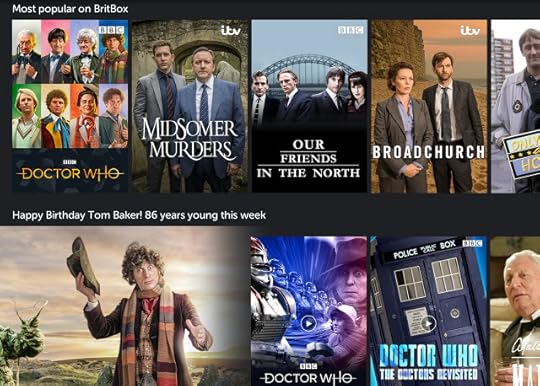
The latest entry into the UK streaming market is BritBox, an extraordinary co-venture between BBC Studios and ITV plc that collects together many of the finest British television programmes ever made along with a Film4-curated British film library. I’m currently around a fortnight into my thirty-day free trial and, even though I have my own fairly comprehensive collection of digital media, I’ve still been impressed by the quality of the service.
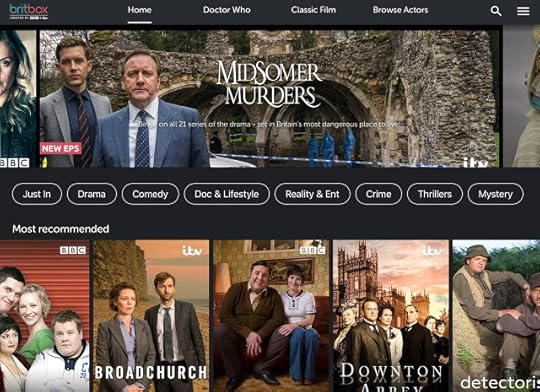
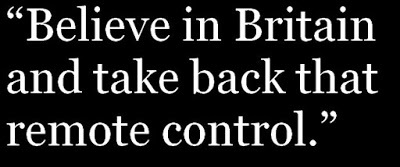 Unlike some of the more awkward platforms like NOW TV and the accursed Amazon Prime, BritBox has clearly styled its apps on Netflix’s friendly and familiar interface. This will be particularly helpful for those would-be subscribers with limited experience of streaming as everything is big, clear and simple – the threat of accidental purchases and false-positive search results of the type that plague the Prime apps are nowhere to be found in BritBox. You just pay your £5.99 per month (about half the current TV licence fee), and receive access to what is justifiably billed as “the biggest box of British Boxsets”.
Unlike some of the more awkward platforms like NOW TV and the accursed Amazon Prime, BritBox has clearly styled its apps on Netflix’s friendly and familiar interface. This will be particularly helpful for those would-be subscribers with limited experience of streaming as everything is big, clear and simple – the threat of accidental purchases and false-positive search results of the type that plague the Prime apps are nowhere to be found in BritBox. You just pay your £5.99 per month (about half the current TV licence fee), and receive access to what is justifiably billed as “the biggest box of British Boxsets”.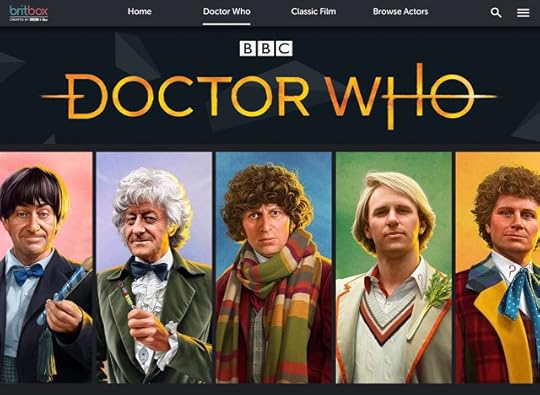
At the moment, the service is selling itself on the strength of its Doctor Who catalogue – the series even has its own tab on the app’s landing page. It’s a risky ploy, given that Netflix currently has the rights to stream ten of the last twelve seasons, but one likely to pay dividends in the long run when rights for the 2005-2017 episodes revert back to the Beeb and the service can host every surviving episode of the thirty-eight-season-strong series. In the meantime, though, even the offer of vintage Who is a great gimmick as in the past the cost of delving into the classic serials might have been off-putting to newcomers – I shudder to think how much I spent building up my DVD collection over two decades, only to find myself starting again with the recent Blu-rays – but now they can watch any surviving episode broadcast between 1963 and 1996 (along with all the lost episodes that have been animated using off-air soundtracks and one or two other little surprises) for what’s essentially a nominal fee. In some ways, then, classic Who is more of a selling point than NuWho will be – after all, in a clear attempt to undermine Netflix’s claim to the programme, every single episode of NuWho is currently available on iPlayer and has been for over a year now. BritBox even boasts the complete fiftieth anniversary talking heads series The Doctors Revisited and Mark Gatiss’s exquisite docudrama An Adventure in Space and Time , both of which are difficult to find in HD in the UK.

Like a lot of Doctor Who fans, I already own everything Who-related on BritBox, but, save for a couple of cheap iTunes season passes from the Steven Moffat era, it’s all on shiny discs. For some reason classic Who has never received a comprehensive or even half-decent digital release – the smattering of downloadable iTunes and Amazon offerings have been pitiful – and so the ease of having it all at your fingertips is fresh and incredibly alluring. Better still, every single episode appears to have been upscaled into high-definition, and although the quality doesn’t quite match that seen on the recent Doctor Who Collection Blu-rays, it does improve upon the DVDs that many of us Who fans still cling to. Even on a massive contemporary TV, the original 1963/64 Dalek serial looks pretty good.

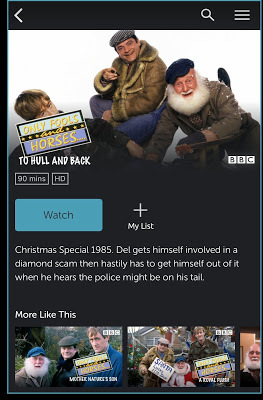 BritBox’s Who library is far from perfect, mind. The 1996 TV movie is inexplicably missing its pre-title sequence, and most – but not all - serials are represented by generic stock photos rather than attractive DVD-style covers. Furthermore, I’m sad to say that there’s still not a streaming service out there that has worked out how to do what MediaPortal was doing effortlessly a decade ago - displaying ‘specials’ into their proper place in a programme’s running order. Who fares better than most on the platform, though; a lot of classic comedies have had their specials uploaded as different shows altogether. Browse Only Fools and Horses and you’ll just see seven seasons, but search for “To Hull and Back” and a separate programme entitled Only Fools and Horses: To Hull and Back pops up. It’s far from slick, but sadly in line with video subscription services’ lazy standards. You’ll probably need Wikipedia open on your phone if you plan to watch anything from start to finish in the right order.
BritBox’s Who library is far from perfect, mind. The 1996 TV movie is inexplicably missing its pre-title sequence, and most – but not all - serials are represented by generic stock photos rather than attractive DVD-style covers. Furthermore, I’m sad to say that there’s still not a streaming service out there that has worked out how to do what MediaPortal was doing effortlessly a decade ago - displaying ‘specials’ into their proper place in a programme’s running order. Who fares better than most on the platform, though; a lot of classic comedies have had their specials uploaded as different shows altogether. Browse Only Fools and Horses and you’ll just see seven seasons, but search for “To Hull and Back” and a separate programme entitled Only Fools and Horses: To Hull and Back pops up. It’s far from slick, but sadly in line with video subscription services’ lazy standards. You’ll probably need Wikipedia open on your phone if you plan to watch anything from start to finish in the right order. The app’s search facility needs a lot of work too. I searched for “Gavin & Stacey”, which is not only the programme’s name but also how it’s stylised on all of its posters and promotion material, and nothing came up. Yet when I searched for “Gavin and Stacey”, without the ampersand, it brought the series up straightaway as it had been erroneously uploaded as “Gavin and Stacey” and the app isn’t sophisticated enough to realise that “&” and “and” mean exactly the same (and in this case, the & was actually more accurate.

In terms of content, though, what’s already on offer is astonishing, and the library will only grow when Channel 4’s “1000+” hours of content is thrown into the mix this Spring followed by Film4’s later in the year. I also expect to see BBC and ITV content pulled from other platforms as their streaming rights come up for renewal, just as Disney have been doing with their own content now that they have Disney+ to host it, but sadly this is unlikely include any co-ventures such as the recent Dracula.
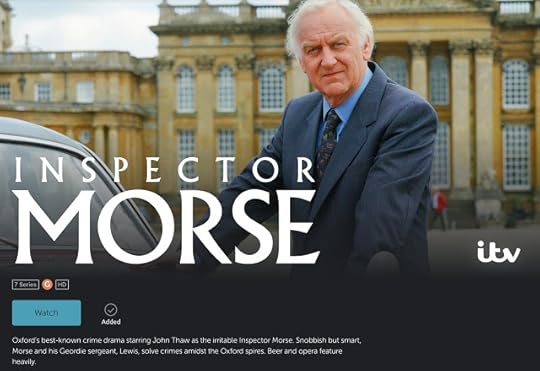
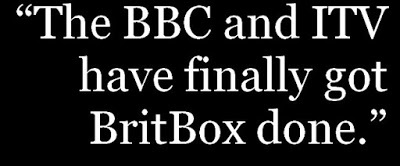 My wife and I are likely to spend the next six months wading through two decades’ worth of Midsomer Murders, which we’ve just discovered, and that’s just one of the revered detective dramas to come out of ITV that you’ll find preserved here, all ad-free. Inspector Morse; Lewis; and Endeavour all have a home on BritBox, the old Morses available in high definition (it was originally shot on film) for the first time, alongside fluffier and wackier efforts from the BBC such as Death in Paradise and Life on Mars / Ashes to Ashes. On top of this, you’ll find award-winning dramas such as Broadchurch and Downton Abbey, along with a veritable avalanche of classic comedies. Just about anything you can think of ever broadcast on the BBC or ITV is here, and what isn’t probably soon will be. From Porridge to BlackAdder, The Thick of It to Detectorists – it’s comedy heaven. There’s even a growing collection of Carry On films, again remastered in HD. I couldn’t resist guiltily revisiting Carry On Camping before I watched anything else.
My wife and I are likely to spend the next six months wading through two decades’ worth of Midsomer Murders, which we’ve just discovered, and that’s just one of the revered detective dramas to come out of ITV that you’ll find preserved here, all ad-free. Inspector Morse; Lewis; and Endeavour all have a home on BritBox, the old Morses available in high definition (it was originally shot on film) for the first time, alongside fluffier and wackier efforts from the BBC such as Death in Paradise and Life on Mars / Ashes to Ashes. On top of this, you’ll find award-winning dramas such as Broadchurch and Downton Abbey, along with a veritable avalanche of classic comedies. Just about anything you can think of ever broadcast on the BBC or ITV is here, and what isn’t probably soon will be. From Porridge to BlackAdder, The Thick of It to Detectorists – it’s comedy heaven. There’s even a growing collection of Carry On films, again remastered in HD. I couldn’t resist guiltily revisiting Carry On Camping before I watched anything else. 
A slight disappointment with the service is its deference to iPlayer and ITV Hub, which I gather will remain the immediate home for each channel’s new programming for at least a short time after broadcast. We were hoping to watch the new series of Cold Feet without commercial breaks, as subscribers of ITV Hub+ can, but at the time of writing only the show’s first eight seasons are available to stream on BritBox. Don't be fooled by the “9 Series” - the eight earlier seasons are preceded by that troublesome pilot that finds itself the sole occupant of “Season 0”.
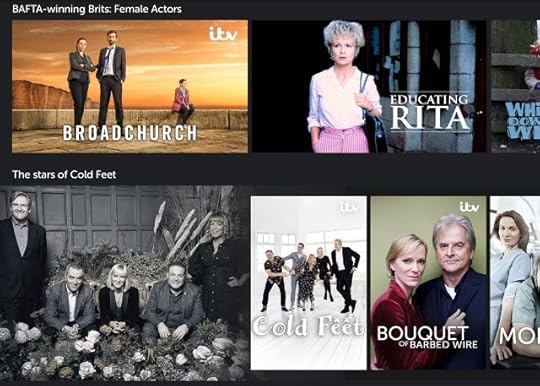
Indeed, the service’s obvious weakness at present is its lack of original content when compared with Amazon Prime and Netflix’s sprawling catalogue of originals (many of which really aren’t… “exclusives” would be a more truthful label), though BritBox’s budget for original programming is reportedly in the tens of millions.
Perhaps BritBox’s biggest problem when measured against its competitors, though, is the dearth of children’s programming – the slogan, “From costume to comedy, drama to detectives, we've got it all,” is really pushing it when, to most people, “it all” includes something for the kids. My eight-year-old daughter’s might be turning square (well, 4:3) thanks to retro Doctor Who (and believe me, eight-year-old me would have died of Vitamin-D deficiency had he suddenly discovered twenty-six seasons of Who on tap), but my three-year-old wants to know what’s happened to Bananaman and Dogtanian - and frankly so do I.
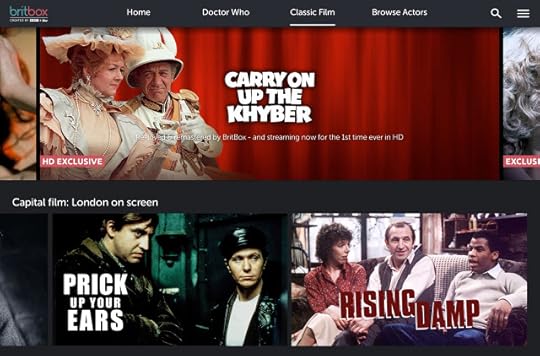
Even as it stands though, BritBox’s ease of use and vast archive is more than enough to justify an outlay of £5.99 per month. For someone like my old mam, who loves nothing more than a classic comedy or Carry On film with her cuppa, it’s an absolute no-brainer, and even for me, with my exhaustive media collection, the numbers still stack up. Before subscribing, I priced up how much it would cost us to watch Midsomer Murders on DVD, or download it from iTunes, and it worked out at more than we’d pay for a couple of years’ subscription. And that’s just for one show.
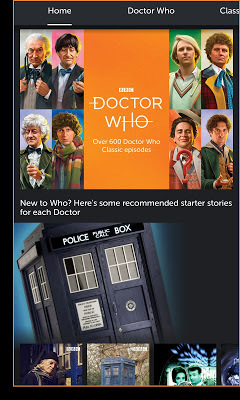 Those familiar with Netflix’s (recently-shelved) free trials will find signing up to BritBox a doddle – all you need is a name, an e-mail address and a payment method. It couldn’t be simpler. The more worrisome of punters can even cancel their subscription immediately and still enjoy the service until their thirty days are up, though I dare say that most who do so will be tempted to reactivate it once they’ve sampled some of the treasures on offer. Admittedly, it’s a system open to abuse, but so was Netflix’s, and if anything the freeloaders only helped to make Netflix a household name.
Those familiar with Netflix’s (recently-shelved) free trials will find signing up to BritBox a doddle – all you need is a name, an e-mail address and a payment method. It couldn’t be simpler. The more worrisome of punters can even cancel their subscription immediately and still enjoy the service until their thirty days are up, though I dare say that most who do so will be tempted to reactivate it once they’ve sampled some of the treasures on offer. Admittedly, it’s a system open to abuse, but so was Netflix’s, and if anything the freeloaders only helped to make Netflix a household name. BritBox has, however, eschewed Netflix’s multiple users on one account setup – here you only get one list, and so if you start sharing your login you’re quickly going to be swamped with other people’s half-watched shows and terrible tastes. All the same, there doesn’t seem to be a limit on how many devices you can sign in on – I’m presently logged in on my iPhone, iPad and two Apple TVs – but I’ve never tried to use them concurrently, and as it’s mainly just my wife and I watching BritBox (sorry kids), I don’t foresee ever needing to.
In the US, BritBox is a popular niche service – over here, though, it’s our bread and butter. So believe in Britain and take back that remote control, because if there’s anything out there that can heal the cracks in a divided nation, it’s this service. The BBC and ITV have finally got BritBox done.
Try it free for thirty days by clicking here.
Published on January 15, 2020 14:54
January 13, 2020
TV Review | Doctor Who: “Orphan 55” by Ed Hime
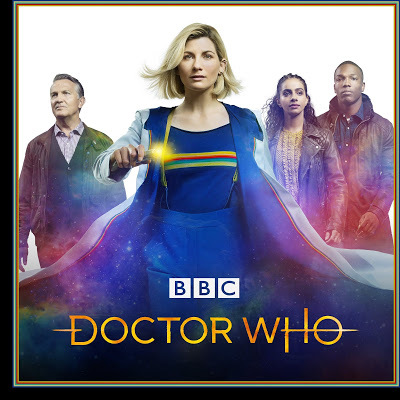 From its trailer and promotion, I had expected Ed Hime’s “Orphan 55” to be a bit of a filler, really – a frothy, base-under-siege romp with only the scorching Spanish sun to set it apart from the many similar stories that it follows. However, it seems that after the Christmas-break comfort food of the two-part Skyfall, Doctor Who has snapped back to the format of the show’s dazzling 2018 run with an incessantly entertaining and flagrantly provocative piece that combines cutting-edge thrills with even more frightening ecological realities in a manner reminiscent of the old Jon Pertwee serial,
The Green Death
.
From its trailer and promotion, I had expected Ed Hime’s “Orphan 55” to be a bit of a filler, really – a frothy, base-under-siege romp with only the scorching Spanish sun to set it apart from the many similar stories that it follows. However, it seems that after the Christmas-break comfort food of the two-part Skyfall, Doctor Who has snapped back to the format of the show’s dazzling 2018 run with an incessantly entertaining and flagrantly provocative piece that combines cutting-edge thrills with even more frightening ecological realities in a manner reminiscent of the old Jon Pertwee serial,
The Green Death
.Holidays for the Doctor have never worked out well, but her visit to Tranquillity Spa stands out as a particularly calamitous attempt. Within moments of arrival, Ryan has contracted a virus from a vending machine and vicious apex predators are running off with the guests. A few blinks later and the gang are running out of oxygen as they are forced to flee across the barren surface of a dead planet in a battered all-terrain vehicle while their fellow survivors drop bombs... in every sense of the phrase. Such perils are made to seem paltry, though, when the Doctor discovers a rusted Russian sign and a tell-tale “made in China” brass plate. This, we realise, is a holiday much closer to home than the Doctor and her extended fam had anticipated.

Of course, ending the world isn’t that big a deal in Doctor Who – the revived series wore the Earth’s doom like a badge of honour in just its second episode, and even that fatalistic affair was merely continuing a long tradition of the programme ravaging our beautiful blue planet with solar flares and/or flinging it across time and space and renaming it Ravolox. “Orphan 55”, though, has a much more uncomfortable sense of propinquity about it, and it’s far from shy when it comes to laying blame. As the global climate change crisis escalates, so does Doctor Who’s response to it – the decorous subtlety of The Green Death has been supplanted by the Kitchener-like image of a Time Lord pointing straight through your TV screen at you.
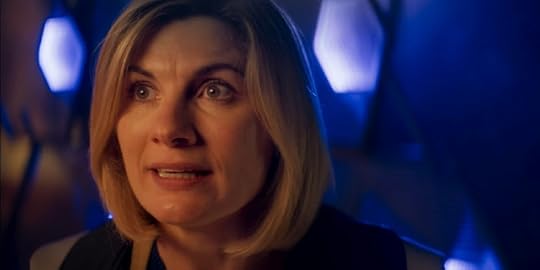 “Unless people face facts and change, catastrophe is coming.”
“Unless people face facts and change, catastrophe is coming.” 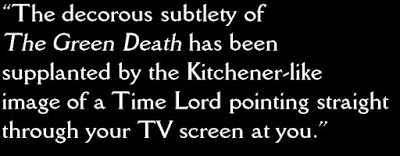 Whereas Skyfall was remarkable for giving each of the Doctor’s friends something significant to do, “Orphan 55” is notable for its tight focus on Ryan, and, through him, the fascinating Kane / Bella relationship. Hime uses the estranged mother and daughter to cleverly reflect the horrific dregs of humanity that roam Orphan 55, with Kane (fiercely played by
Breaking Bad
’s secret Scot Laura Fraser) epitomising the avarice and apathy that might well bring our world to ruin, and her unforgiving daughter (Gia Ré) embodying the irresponsible anger that lurks beneath every mushroom cloud. Crucially, though, Hime shows that neither character is beyond redemption – nor, it seems, is the Earth itself. Through great arks in space (plural) or on brand new worlds like New Earth, Doctor Who has always been at pains to show that humanity will endure even without its home world, and whilst for the most part “Orphan 55” paints a much ghastlier picture than this, it does still offer the Earth of the Whoniverse the possibility a different future - even if in doing so it has to tear up the rulebook when it comes to the old “you can’t change history” problem. A volcano erupting in 79 AD is obviously a fixed point in time that couldn’t possibly be altered, whereas the entire planet being devastated by climate change and nuclear war remains conveniently open to revision. It’s one of the show’s most ambitious fudges, but it’s needed to turn what could have been a funeral dirge into a rousing call to arms.
Whereas Skyfall was remarkable for giving each of the Doctor’s friends something significant to do, “Orphan 55” is notable for its tight focus on Ryan, and, through him, the fascinating Kane / Bella relationship. Hime uses the estranged mother and daughter to cleverly reflect the horrific dregs of humanity that roam Orphan 55, with Kane (fiercely played by
Breaking Bad
’s secret Scot Laura Fraser) epitomising the avarice and apathy that might well bring our world to ruin, and her unforgiving daughter (Gia Ré) embodying the irresponsible anger that lurks beneath every mushroom cloud. Crucially, though, Hime shows that neither character is beyond redemption – nor, it seems, is the Earth itself. Through great arks in space (plural) or on brand new worlds like New Earth, Doctor Who has always been at pains to show that humanity will endure even without its home world, and whilst for the most part “Orphan 55” paints a much ghastlier picture than this, it does still offer the Earth of the Whoniverse the possibility a different future - even if in doing so it has to tear up the rulebook when it comes to the old “you can’t change history” problem. A volcano erupting in 79 AD is obviously a fixed point in time that couldn’t possibly be altered, whereas the entire planet being devastated by climate change and nuclear war remains conveniently open to revision. It’s one of the show’s most ambitious fudges, but it’s needed to turn what could have been a funeral dirge into a rousing call to arms.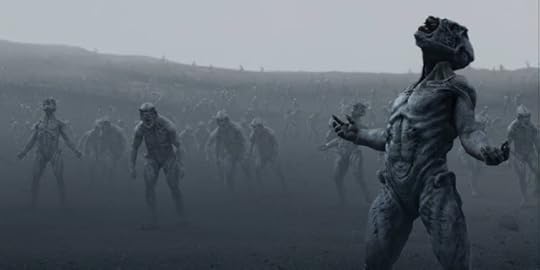
And though not quite as powerful as its story’s message, the look of “Orphan 55” is nonetheless forcefully stunning. The Auditorio de Tenerife does a thoroughly convincing job of passing itself off as an oasis on a dead planet, while the gruesome Dregs elevate the series’ fear factor to a level unseen since David Tennant’s Doctor faced down the Devil almost fourteen years ago. Lee Haven Jones’ stylistic direction frames the CO2-breathing apex predators perfectly – close-ups, light flares, sharp cuts and even dropped frames conspire to deliver a monster that, for once, isn’t meant to evoke any other feeling than dread.
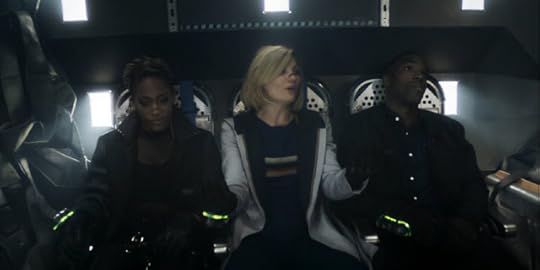 “What you talking about?” / “Er… Er… We both have dead parents.”
“What you talking about?” / “Er… Er… We both have dead parents.”However, despite the heavy subject matter, Hime’s script is still laden with levity. Tosin Cole’s awkward Romeo might be this episode’s beating heart, but, sucking his thumb as he convalesces and flirts, he’s at the centre of much of its humour too. Jodie Whittaker’s Doctor is also at her oblivious best, interrupting budding romance with the same sort of gaucherie that she usually reserves for excessively complimenting tails, while supporting players James Buckley (The Inbetweeners, Rock & Chips) and Lewin Lloyd provide a father and son team that you can laugh at while they steal your heart.

Make no mistake, the Doctor Who team will probably take more flack for this one than they did Chris Chibnall’s Brexit gag in “Resolution”, but it will certainly be worth it. “Orphan 55” will long be remembered as a fast-paced and thrilling adventure that made the programme’s boldest and most explicit statement about the world that we live in.
Sometimes even the Doctor can’t save the world. Sometimes it’s down to us.
Doctor Who airs on Sunday evenings on BBC 1 and is available to stream for the foreseeable future on BBC iPlayer. A season pass comprising all ten episodes of the season in 1080p HD and bonus material is also available from iTunes for £20.99, with episodes typically becoming available the day after their transmission on BBC 1. A Blu-ray steelbook is also available to pre-order from Amazon for £49.99.
Published on January 13, 2020 14:29
January 5, 2020
Film Review | Star Wars: The Rise of Skywalker directed by J J Abrams
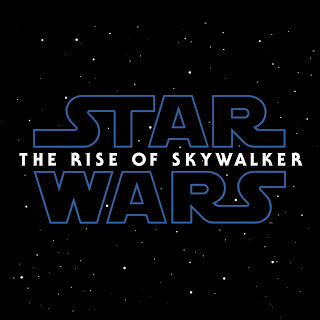 You can’t please everyone, so Disney have decided to let people take it in turns.
The Last Jedi
’s detractors will no doubt exult in The Rise of Skywalker’s resolute eschewing of almost every single aspect of Rian Johnson’s notorious masterpiece, whereas those who celebrated The Last Jedi’s unique take on the franchise are probably going to feel as furious as their opposite numbers did the last time around. Whichever side of the divide you find yourself on, though, there is no escaping the fact that Disney’s
Star Wars
trilogy now feels like a contrived and ultimately unsatisfying mess. It is, at best, a strained duology with a largely meaningless side-step in the middle.
You can’t please everyone, so Disney have decided to let people take it in turns.
The Last Jedi
’s detractors will no doubt exult in The Rise of Skywalker’s resolute eschewing of almost every single aspect of Rian Johnson’s notorious masterpiece, whereas those who celebrated The Last Jedi’s unique take on the franchise are probably going to feel as furious as their opposite numbers did the last time around. Whichever side of the divide you find yourself on, though, there is no escaping the fact that Disney’s
Star Wars
trilogy now feels like a contrived and ultimately unsatisfying mess. It is, at best, a strained duology with a largely meaningless side-step in the middle.When considered separately, each instalment is a phenomenal film in its own right, but taken together they suffer from a lack of cohesion - the blame for which rests squarely on the shoulders of The Rise of Skywalker. A careful play upon nostalgia, The Force Awakens delivered exactly what those who didn’t care for the prequel trilogy wanted: a riff upon the original Star Wars movie. It essentially told the exact same story, but from different angles and with a modern sheen. And for all its controversy, The Last Jedi did much same thing, taking the core elements of The Empire Strikes Back and casting them in a new and excruciatingly beautiful mould; one that, somehow, even managed to replicate Empire’s ability to shock. With different writers and directors at the helm, this trilogy’s first two episodes were like day and night – not unlike the original Star Wars movie and The Empire Strikes Back.


This new trilogy’s final instalment, saddled with the awkward (if initially intriguing) title The Rise of Skywalker, is a movie defined by relentless excitement and unremitting spectacle. I found it to be the most visually and aurally impressive of all twelve Star Wars movies, and its beauty wasn’t just skin deep. The performances painted on Abrams’ stunning canvas were fittingly formidable for the final act in an historic ennealogy, with Daisy Ridley and Adam Driver delivering such staggering intensity that they almost papered over the inherent narrative cracks. Certainly the most fascinating and rewarding part of The Rise of Skywalker was its deft handling of its central Rey / Ren relationship, the evolution and inexorable conclusion of which seemed to flow organically. It speaks volumes that the eleventh-hour introduction of a whole new concept in the Force doesn’t feel forced at all – my reaction to it, which I’m sure that many people will share, was simply, “Of course.”

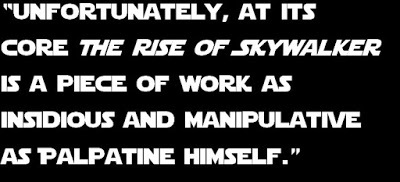 Similarly, the much-hyped return of Ian McDiarmid as Sheev Palpatine / Darth Sidious was a coup impossible not to applaud. The very existence of this sequel trilogy destroys the once sacrosanct idea that the episodic Star Wars saga is the story of Anakin Skywalker’s fall and redemption, but at least resurrecting his former Sith master and emperor gave this trilogy of trilogies an overarching big bad to tie it all together. It did make a mockery of Snoke, of course (well, fans did clamour for details of his origins...), but this is offset somewhat by the rather neat revelation that Ren’s inferred communion with Darth Vader via his charred helmet was actually with Palpatine – it used to annoy me no end that Anakin died a Jedi, only to then cause ructions from the Netherworld of the Force by whispering iniquitous incitements to his grandson. Furthermore, having Palpatine return using the very power that seduced Anakin to the dark side was a tremendously gratifying stroke; one topped only by basing him on the legendary hidden world of the Sith amongst a whole cadre of Sith Eternal loyalists and a fleet of freshly-minted star destroyers each armed with Death Star tech. Locked in a cadaverous state, the erstwhile emperor’s early scenes fused Hammer horror with shameless fan service in a manner that felt wickedly satisfying, if ultimately a little shallow.
Similarly, the much-hyped return of Ian McDiarmid as Sheev Palpatine / Darth Sidious was a coup impossible not to applaud. The very existence of this sequel trilogy destroys the once sacrosanct idea that the episodic Star Wars saga is the story of Anakin Skywalker’s fall and redemption, but at least resurrecting his former Sith master and emperor gave this trilogy of trilogies an overarching big bad to tie it all together. It did make a mockery of Snoke, of course (well, fans did clamour for details of his origins...), but this is offset somewhat by the rather neat revelation that Ren’s inferred communion with Darth Vader via his charred helmet was actually with Palpatine – it used to annoy me no end that Anakin died a Jedi, only to then cause ructions from the Netherworld of the Force by whispering iniquitous incitements to his grandson. Furthermore, having Palpatine return using the very power that seduced Anakin to the dark side was a tremendously gratifying stroke; one topped only by basing him on the legendary hidden world of the Sith amongst a whole cadre of Sith Eternal loyalists and a fleet of freshly-minted star destroyers each armed with Death Star tech. Locked in a cadaverous state, the erstwhile emperor’s early scenes fused Hammer horror with shameless fan service in a manner that felt wickedly satisfying, if ultimately a little shallow. But then that’s Sith for you.

The Rise of Skywalker also succeeded in the finest Star Wars tradition of delivering new and exotic locales, from an asteroid of ice through the Bollywood-inspired deserts of Pasaana all the way to the violent seas of Kef Bir in the Endor system. Its centrepiece lightsaber duel broke new ground as Rey and Ren locked laser swords aboard the wreck of a Death Star while a tsunami broke around them. Poe made the Millennium Falcon do shit that makes confusing units of distance and time seem pedestrian in contrast. The Knights of Ren were expectedly awesome, if unexpectedly mute. Charming new characters like the hilarious droidsmith Babu Frik and Poe’s fiery old flame Zorri Bliss stole every scene that they were in, while the oldest of hands were given the send-off that they deserved. Having been kept on the sidelines in both The Force Awakens and The Last Jedi, it was a real joy to see C-3PO not merely back in the thick of things, but driving the plot as his astromech friend so famously did all the way back in 1977. Anthony Daniels’ long-suffering droid drew the biggest laughs of the film both times that I went to see it, yet his role still managed to stand out as one of the most poignant.
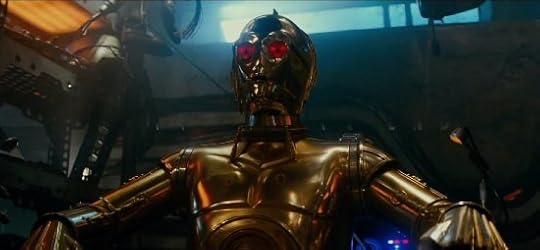
Director J J Abrams(Star Trek, Star Trek Into Darkness) and his co-writer Chris Terrio’s ( Batman v Superman: Dawn of Justice , Justice League) story was also notable for its adherence to George Lucas’s original themes. There was a palpable nature versus industry vibe with wild warriors galloping across the surface of star destroyers mounted on horse-like beasts as the saga’s grand showdown pitted the galaxy’s greatest-ever navy against an overwhelming mass of “Just people” (just as in merely, just as in righteous). The magnitude of such moments was emphasised magnificently by what will probably be John Williams’ final Star Warsscore, which for the first time incorporated the saga’s signature theme within the main body of the movie, the emotional impact of which can’t be overstated. It was hard not to punch the air repeatedly as Lando’s cavalry arrived to the sound of those grand, immortal notes. Like a lot of us, I’m sure that Lucas will have major reservations about The Rise of Skywalker, but I still can’t help but feel that he would give his blessing to its spirit, if not its letter.
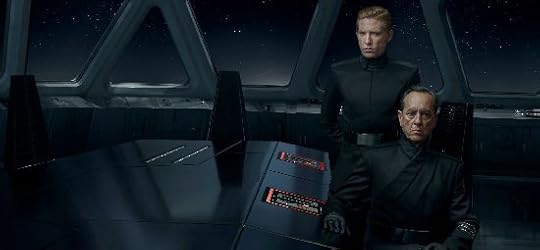
The First Order turned Sith Final Order (Palpatine had clearly given up on his “I’m just an old politician...” propaganda by 35ABY) dextrously walks the tightrope between comic relief and credible threat. I was particularly pleased with the payoff to General Hux’s long-running feud with his supreme leader – there really was no other way to square that circle – and Richard E Grant’s Allegiant General Pryde did a terrific job of usurping his place as the face of the First Order’s military. He was no Wilfhuff Tarkin, mind, and especially given the movie’s setting in the Unknown Regions I would have much preferred to see a live-action Grand Admiral Thrawn feature in the place of Grant’s new character. It seemed like a no-brainer to me, given the history of service to Palpatine that’s alluded to in the dialogue, but I suppose that Abrams did have to draw a line somewhere when it came to fan service. A conspicuously left-handed Force ghost who’d finally learned how to raise his X-Wing up from the water and a ghostly, arrogant voice urging Rey to, “Bring back the balance as I did,” (the cheeky fucker) was probably enough fanwank for one movie.

All the same, at times Abrams’ devotion to what had come before crossed the line from homage to barefaced plagiarism – the scene in which Kylo Ren attacked one of his command officers caused my friend to throw a hand in the air in defeat and proclaim, “It’s just a fucking remake!” I still took guilty pleasure in such scenes, especially when viewed through the prism of Kylo Ren’s evident success, which as a huge fan of the character I have a vested interest in. When Darth Vader Force-choked Admiral Motti on board the first Death Star, he had Tarkin holding his leash. Ren, however, achieved what his grandfather could not by becoming supreme leader of the galaxy’s most dominant force, beholden to no-one. This only served to make his ultimate redemption all the more extraordinary, given the extent of the power that he had to surrender – all Vader was really giving up to save his son was work as a high-profile enforcer, and even that role was precarious as his boss had been actively looking to replace him.
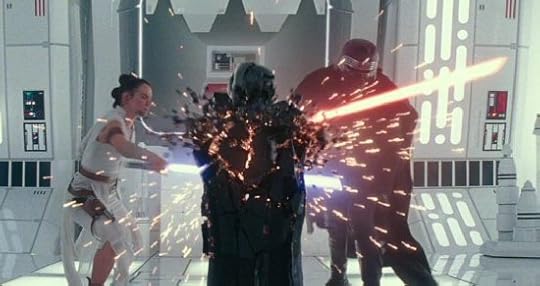
Ren’s brief dominion over the galaxy, when measured against Vader’s subservience to his master, is quite emblematic of Ren’s character, both within the fiction and without. Whilst Ren will never be the cinematic icon that Darth Vader is, in-universe he is a much greater success, first rising to rule and later attaining the power over life and death that Vader so tragically sought. Conceptually, he is a character with much greater depth than Vader, and moreover it is much easier for an audience to identify with him. Abrams struck gold with the notion that Ren’s mask should be just a façade, allowing us to see the character’s conflict writ across his face in all the scenes that counted.
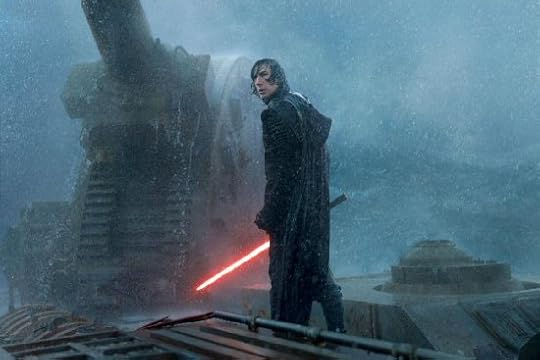
The apotheosis of these was, without doubt, the moment on the wreck of the second Death Star where, in the aftermath of his mother’s death, Kylo Ren faced Ben Solo’s memory of his father, and the weight of it crushed him. It managed to call back to two defining scenes in the saga (Han’s “I know” in Empire and Ren’s “I know what I have to do...” in The Force Awakens), and serve as a beautiful coda to both, as well as Leia’s immediately preceding sacrifice, all the while setting the stage for the inevitable Team: Skywalker vs Emperor Palpatine showdown. It’s hands-down the greatest scene in the sequel trilogy, and one of the most memorable of the entire saga. The script was exquisite, and Harrison Ford and Adam Driver’s performances were simply transcendent.
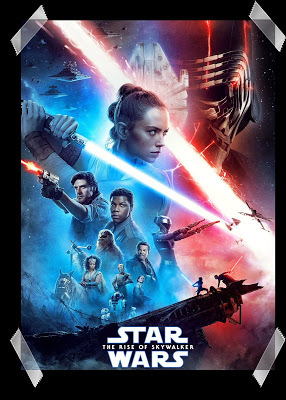 Unfortunately though, at its core The Rise of Skywalker is a piece of work as insidious and manipulative as Palpatine himself. Whereas Lucas was able to oversee all three films in his original trilogy, ensuring that its ever-evolving and self-contradicting narrative at least built upon what had come before, here Disney allowed two very different artists with clearly very different visions to play tennis with their billion-dollar franchise. Rian Johnson knocked back Abrams’ opening serve with The Last Jedi, and this film is Abrams’ over-egged and overpowering response.
Unfortunately though, at its core The Rise of Skywalker is a piece of work as insidious and manipulative as Palpatine himself. Whereas Lucas was able to oversee all three films in his original trilogy, ensuring that its ever-evolving and self-contradicting narrative at least built upon what had come before, here Disney allowed two very different artists with clearly very different visions to play tennis with their billion-dollar franchise. Rian Johnson knocked back Abrams’ opening serve with The Last Jedi, and this film is Abrams’ over-egged and overpowering response.Not content with flying in the face of The Last Jedi’s quiet beauty and more meditative tone, The Rise of Skywalker made it its mission to completely retcon its divisive predecessor - sadly to the cost of its own credibility. After the pains that Johnson went to to emphasise Rey’s lack of Force pedigree, the reveal that she’s actually Emperor Palpatine’s granddaughter simply doesn’t ring true. Even within the context of the film, the logistics didn’t work – the implication was that Rey having Palpatine’s blood in her veins automatically conferred colossal Force powers upon her, despite her father (whose inheritance from his own father should surely have made him even more powerful than Rey?) not even being able to muster enough strength to keep his wife and child safe. Worse, it flew in the face of the well-established conceit that Palpatine’s power isn’t purely innate, but earned through decades of dedication to mastery of the dark side of the Force. This guy wasn’t born with the power to bring himself back from the dead – he studied under Darth Plagueis, the Wise.
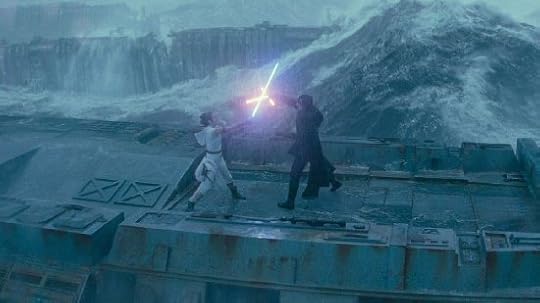 “My mother was the daughter of Vader. Your father was the son of the Emperor. What Palpatine doesn’t know is we’re a dyad in the Force, Rey. Two that are one.”
“My mother was the daughter of Vader. Your father was the son of the Emperor. What Palpatine doesn’t know is we’re a dyad in the Force, Rey. Two that are one.” Admittedly, the original trilogy wasn’t technically any better in this regard. Despite his protestations otherwise, Lucas’s decision to recast Darth Vader as Luke Skywalker’s father in The Empire Strikes Back was clearly an afterthought, as was the concept of Leia being Luke’s twin sister that was belatedly introduced in
Return of the Jedi
– a couple of make-outs too late for most people’s sensibilities (this was in the days before
Game of Thrones
, remember). Haven’t you ever wondered why Luke retained the dead-giveaway name “Skywalker” after Obi-Wan left him with the Lars family on Tatooine, while Leia took her adoptive parents’ surname? Or why Obi-Wan doesn’t call Vader “Anakin” when they finally meet again on the Death Star? And that’s before we even consider Obi-Wan’s seemingly out-of-character lies (sorry - truths “from a certain point of view”) and Luke and Leia’s snogging. In contrast, The Rise of Skywalker’s backtracking is positively polished.
Admittedly, the original trilogy wasn’t technically any better in this regard. Despite his protestations otherwise, Lucas’s decision to recast Darth Vader as Luke Skywalker’s father in The Empire Strikes Back was clearly an afterthought, as was the concept of Leia being Luke’s twin sister that was belatedly introduced in
Return of the Jedi
– a couple of make-outs too late for most people’s sensibilities (this was in the days before
Game of Thrones
, remember). Haven’t you ever wondered why Luke retained the dead-giveaway name “Skywalker” after Obi-Wan left him with the Lars family on Tatooine, while Leia took her adoptive parents’ surname? Or why Obi-Wan doesn’t call Vader “Anakin” when they finally meet again on the Death Star? And that’s before we even consider Obi-Wan’s seemingly out-of-character lies (sorry - truths “from a certain point of view”) and Luke and Leia’s snogging. In contrast, The Rise of Skywalker’s backtracking is positively polished.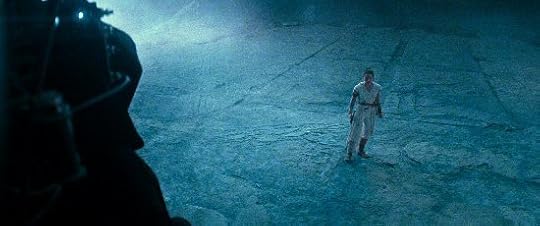
For all their clumsiness, though, the twists and turns of original trilogy worked unbeatably on a character level. The Rise of Skywalker’s didn’t. Revealing Palpatine as the killer of Rey’s parents would have been sufficient for this film’s purposes, but making her his blood relative added nothing to her character – quite the opposite, in fact. I loved the idea of Rey being the Force’s natural response to the growing strength of Kylo Ren, just as I did the core underlying theme that anyone could become a Jedi, no matter what their background. Both ideas were killed stone dead by The Rise of Skywalker, and all because Abrams sought to replicate The Empire Strikes Back’s defining twist – which was, of course, exactly what cinemagoers expected him to do. Chicago Tribune’s Michael Phillips hit the nail on the head when he coined the phrase, “soothingly predictable.” At its worst, The Rise of Skywalker is a balm for those burned by The Last Jedi; a comfort blanket for the half of fandom who wanted a modern reimagining of the original trilogy, and no more.
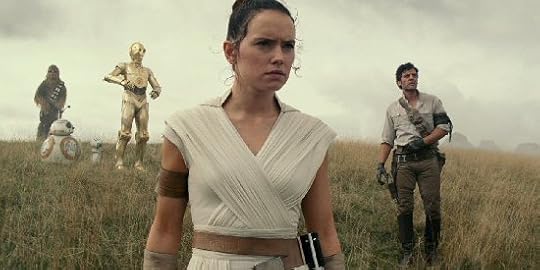
However, as much as the Rey retcon vexed me, its impact was lessened by the fact that I was expecting that particular “twist” – or at least one very much like it. What I wasn’t expecting was for other principal characters to also be given a needless, last-minute reboot. I watched agog as Poe was suddenly turned into a poor man’s Han Solo, with a suitably chequered past to boot. Whilst Abrams and Terrio broadly honoured the character’s journey from recklessness to responsibility, it was tarnished by both a tardy and ill-fitting revelation about his drug-running past and a frankly unfathomable interpersonal three-way dance with Rey and Finn. At the start of the movie, Abrams was doing his best Irvin Kershner impression as Rey and Poe sparred just like Han Solo and the princess, sparks flying everywhere as they bravely flouted their dirty hands, only for their budding sexual tension to collapse into a bizarre sort of threeism with Finn, whose own feelings for Rey have been left curiously ambiguous (which on reflection is probably the film’s sole original move, and one of the better things about it as a result).
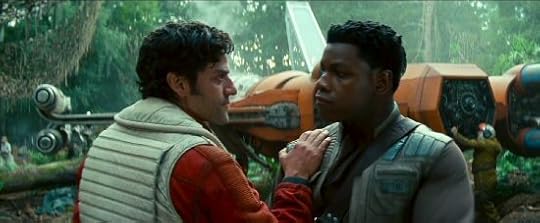
Indeed, once again John Boyega’s Finn was a raucous pleasure. One of The Rise of Skywalker’s greatest strengths is its razor-sharp running banter, most of which has the stormtrooper-turned-freedom fighter at its centre. Unfortunately for him, though, his character is diluted to the point of dissolution by the arrival of an entire legion of his former comrades, who we learn shared in his not-wanting-to-kill-for-the-First-Order epiphany. Instead of one brave and unique individual who bucked the trend, a man we can champion, they’re all at it. It left me feeling foolish, as if I’d just wasted two movies clapping a schookid who’s learned to say no to cigarettes.
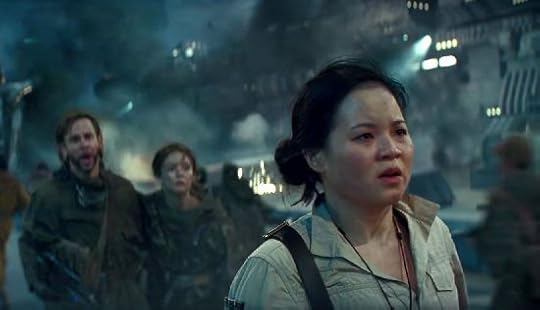 Still, Finn could have fared worse – in an apparent endorsement of toxic fandom and casual racism, his Last Jedi companion, Rose Tico, was relegated to a humiliating walk-on part. If I were a Disney executive, I’d have been very concerned about the optics on this film. Whilst some of the new characters are black, they only seem to have meaningful interaction with existing black characters, and the entire saga’s only same-sex kiss lasts for less than a few seconds (in the territories that were allowed to keep that bit in, anyway). Particularly when taken together with The Rise of Skywalker’s thematic shift from meritocracy back to aristocracy, it feels like a surrender to the misogyny and racism that formed much of the social media reaction to The Last Jedi. Populism strikes again.
Still, Finn could have fared worse – in an apparent endorsement of toxic fandom and casual racism, his Last Jedi companion, Rose Tico, was relegated to a humiliating walk-on part. If I were a Disney executive, I’d have been very concerned about the optics on this film. Whilst some of the new characters are black, they only seem to have meaningful interaction with existing black characters, and the entire saga’s only same-sex kiss lasts for less than a few seconds (in the territories that were allowed to keep that bit in, anyway). Particularly when taken together with The Rise of Skywalker’s thematic shift from meritocracy back to aristocracy, it feels like a surrender to the misogyny and racism that formed much of the social media reaction to The Last Jedi. Populism strikes again. 
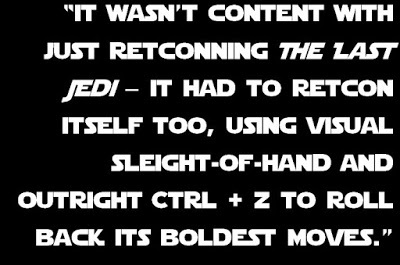 Ultimately the thing that annoyed me most about The Rise of Skywalker though was that it wasn’t content with just retconning The Last Jedi – it had to retcon itself too, using visual sleight-of-hand and outright Ctrl + Z to roll back some of its boldest moves. Chewbacca’s death was devastating, glorious and gut-punchingly perfect. It gave one of the saga’s most celebrated heroes an appallingly unforgettable end, while at the same time making the audience really start to fear their own heroine. It was such an audacious move that, obviously, it lasted for all of ten minutes – after all, Chewie had to survive to get his old medal back.
Frozen
II had more gumption.
Ultimately the thing that annoyed me most about The Rise of Skywalker though was that it wasn’t content with just retconning The Last Jedi – it had to retcon itself too, using visual sleight-of-hand and outright Ctrl + Z to roll back some of its boldest moves. Chewbacca’s death was devastating, glorious and gut-punchingly perfect. It gave one of the saga’s most celebrated heroes an appallingly unforgettable end, while at the same time making the audience really start to fear their own heroine. It was such an audacious move that, obviously, it lasted for all of ten minutes – after all, Chewie had to survive to get his old medal back.
Frozen
II had more gumption.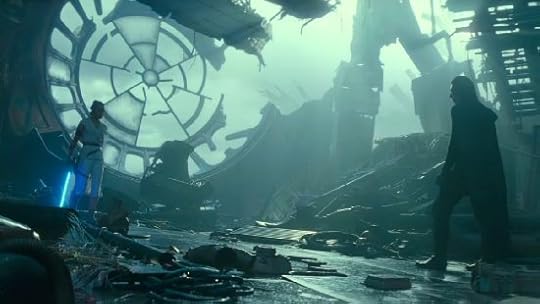
Rey’s resurrection was even more exasperating. She gave her life to destroy Palpatine once and for all (or until Episode X eventually drops...), leading to the most beautiful and unexpected inversion of Return of the Jedi. I found it profoundly affecting to see Ben Solo survive, cradling the body of the woman with whom he’d shared a unique bond, and perhaps even loved - only for Abrams and Terrio to then pull a clichéd double flip and have Ben literally exchange his life for Rey’s. Instead of exploring the difficult questions of accountability and duality that Anakin’s death dodged back in ’83, The Rise of Skywalker served up an apparently fire-retardant homestead and what may be the most unsafe instance of weapons disposal in any universe, fictional or otherwise. I’m still not sure which is harder to swallow – Rey’s painfully manufactured adoption of the Skywalker surname (which obviously has none of the negative connotations of Palpatine. Hang on, wasn’t Darth Vader a...?), or the fact that she’s buried two lethal laser swords in an area home to a primitive race who literally style themselves as Tusken Raiders.
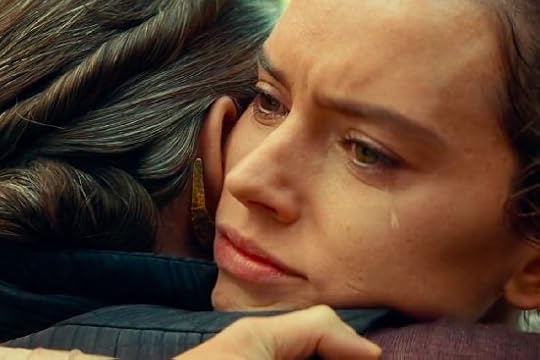
I have more sympathy when it comes to Abrams and Terrio’s reimagining of Leia as a fully-fledged Jedi master, given that they faced the apparently insurmountable obstacle of losing the actress whose character was planned to be at the heart of the movie before they’d even put pen to paper. Building a story that was both suitably reverential and practically achievable was inevitably going to involve some rather radical storytelling, and so the fact that Leia’s arc in The Rise of Skywalker worked at all, let alone worked as well as it did, is a near miraculous achievement for all those involved in delivering Carrie Fisher’s final performance. Watch the film once, and I dare say that you’ll be hard pressed to notice anything amiss. Plot-serving and character-sensitive scenes have been extrapolated from often the most bizarre snippets from the cutting room floor. Yes, the blocking was weird and the camera angles were odd; sometimes the CG outfits didn’t even fit quite right, but overall the result was unbelievable in its believability. Even as the film progressed and the useable footage ran out, Maz Kanata became a narrator for the audience in all but name, which, given her quasi-mystical background, seemed to flow quite naturally. Some of Leia’s most affecting scenes saw her being ushered out of the room in the corner of a frame as Maz spoke to the camera, lying alone in near darkness, or even beneath a shroud. Leia’s sacrifice, and its significance, was just about the only part of the film’s plot that felt right to me.
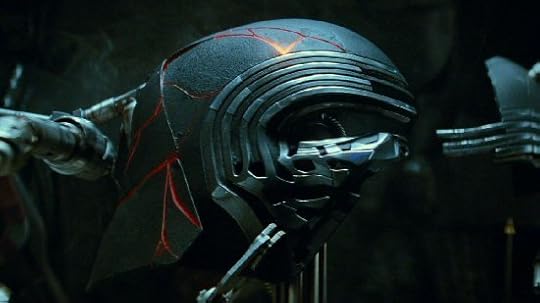
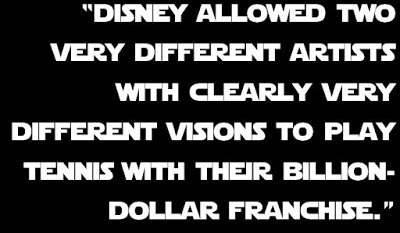 It’s not clear whether Abrams made this film in answer to The Last Jedi’s critics, with a Disney to-do list in hand, or simply to reassert his own vision for the sequel trilogy, but the resultant mess has made a mockery of Disney’s handling of what was, less than a decade ago, its most promising acquisition. To think that Marvel Studios, Lucasfilm’s fellow House of Mouse subsidiary, plan entire phases of movies years in advance - and reap all of the resultant rewards - really brings into sharp focus the executive failings that we’ve witnessed here. In the end, the best thing that I can say about this new Star Wars trilogy is that it’s been so slavishly faithful to George Lucas’s original trilogy that it’s unwittingly inherited its made-up-on-the-fly inconsistencies. Colin Trevorrow, it seems, has had a lucky escape.
It’s not clear whether Abrams made this film in answer to The Last Jedi’s critics, with a Disney to-do list in hand, or simply to reassert his own vision for the sequel trilogy, but the resultant mess has made a mockery of Disney’s handling of what was, less than a decade ago, its most promising acquisition. To think that Marvel Studios, Lucasfilm’s fellow House of Mouse subsidiary, plan entire phases of movies years in advance - and reap all of the resultant rewards - really brings into sharp focus the executive failings that we’ve witnessed here. In the end, the best thing that I can say about this new Star Wars trilogy is that it’s been so slavishly faithful to George Lucas’s original trilogy that it’s unwittingly inherited its made-up-on-the-fly inconsistencies. Colin Trevorrow, it seems, has had a lucky escape.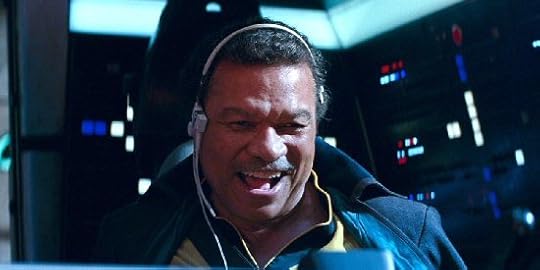
On its own, however, The Rise of Skywalker is a rampant juggernaut of feature that starts better than any other Star Wars film and holds you rapt from there until those twin suns soar. For every hole in its plot, there’s a silver lining lurking; for every badly-drawn character, there’s a heart-rending, rip-roaring performance. You’ll laugh, you’ll cry, and you might even leap up in triumph before going home with your face looking a bit like Kryten’s when he’s trying to lie, before finally coming to the realisation that Star Wars was only ever meant to be the new Flash Gordon – a pulp-fiction, Saturday-morning serial to be enjoyed with a mouthful of popcorn instead of a throatful of bile.
Star Wars: The Rise of Skywalker 4K UHD steelbook is available to pre-order from Zavvi for £32.99 plus £0.99 delivery, and a limited edition 4K UHD box set of the entire “Skywalker Saga” is available to pre-order from Amazon for £180.00.
The Disney+ streaming service launches in the UK on 31st March and will be home to the first eight movies in the saga, with The Rise of Skywalker to follow later in the year (once its theatrical run is complete). The Clone Wars and Rogue One movies are also available, with Solo scheduled to follow in July, in addition to a wide collection of Star Wars TV shows including the exclusive Mandalorian and every episode of both The Clone Wars and Rebels.
Published on January 05, 2020 15:28
E.G. Wolverson's Blog
- E.G. Wolverson's profile
- 52 followers
E.G. Wolverson isn't a Goodreads Author
(yet),
but they
do have a blog,
so here are some recent posts imported from
their feed.



